Damaraland Desert Elephant Safari
The journey continues for our intrepid group of Adventures Abroad explorers as we brave the 40°C (104°F) temperatures of the Namib Desert and Damaraland areas of Namibia in search of the flora and fauna that can survive in these conditions. We have just come from visiting the fabulous rock carvings at the UNESCO World Heritage Site of Twyfelfontein and unlike the creatures native to these parts, we need to find an oasis and soon. Luckily one of our guides, Gerhardus is from this area and knows exactly where to go. After turning down one unsigned dirt road after another we see an apparition on a hill ahead that looks like something right out of Star Wars.
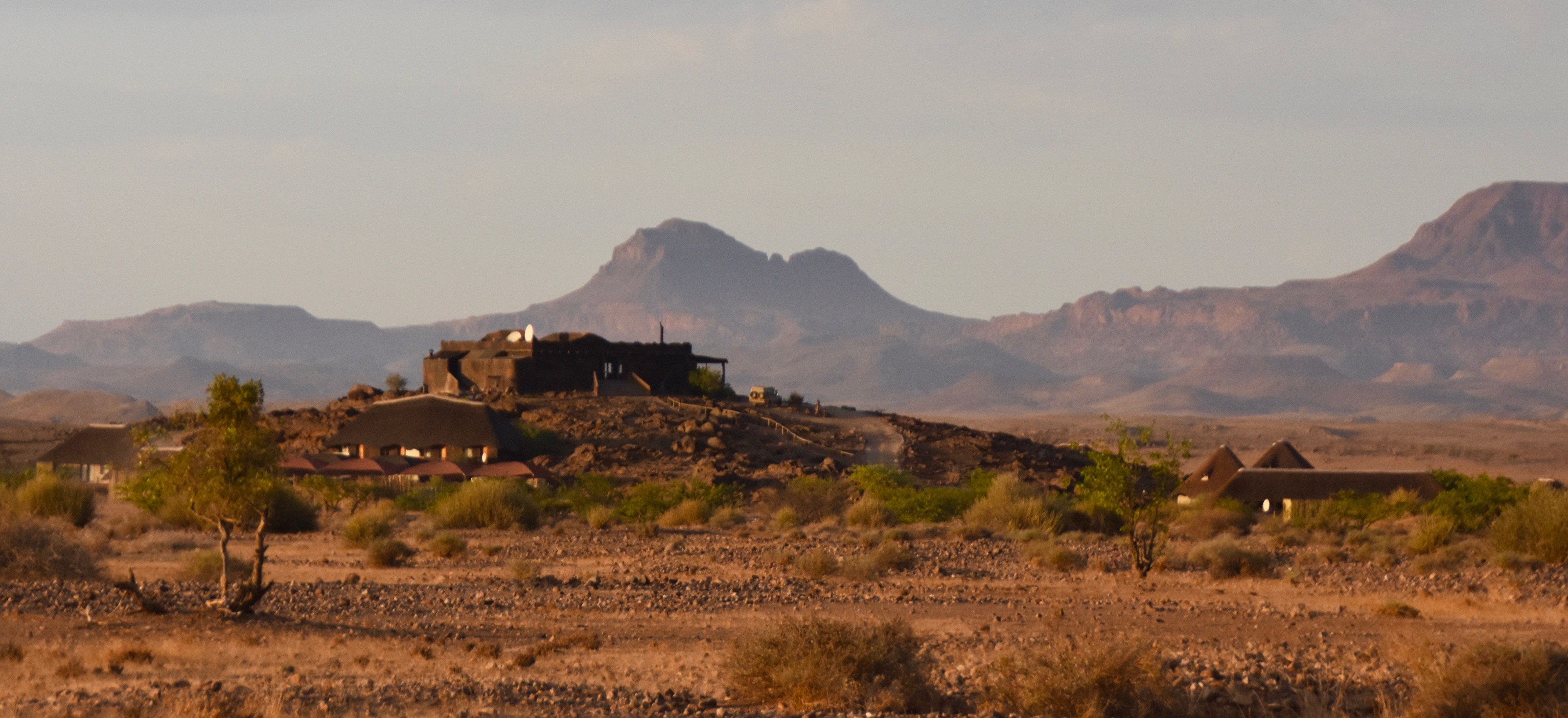
It’s Doro Nawas Wilderness Camp which we will use as our base in trying to track and photograph the elusive desert elephants of Damaraland. Hope you’re up for it.
Doro Nawas
Doro Nawas is one of seven camps operated by Wilderness Safaris in Namibia. In the Sossuvlei area we stayed at the wonderful Kulala Desert Lodge and if this one in Damaraland is half as nice it will be a great experience. As we pull up to the front entrance we are given the traditional greeting by the entire staff singing a welcoming song and offering cold face clothes and ice cold beverages. The camp consists of the central lodge sitting atop a knoll with a 360° vista of the arid and quite beautiful Damaraland topography. Below it are sixteen individual thatched roof cabins with our group taking up about half of them.
This is our unit, number 11. As you can see there are solar panels to generate hot water and in Damaraland you do get your monies worth out of solar panels. No worries about it being cloudy on many days.
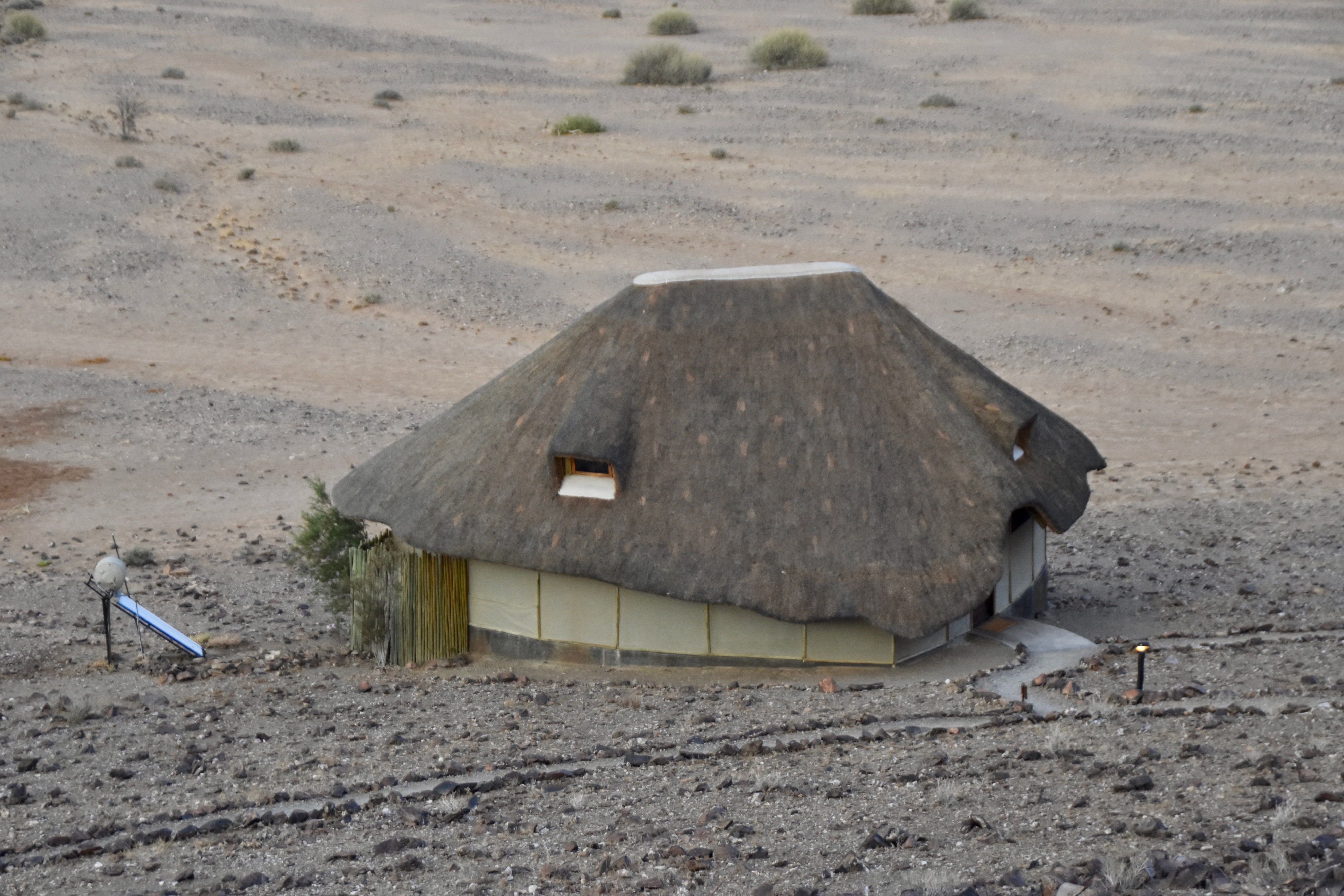
This is the interior, which is very spacious and not exactly roughing it.
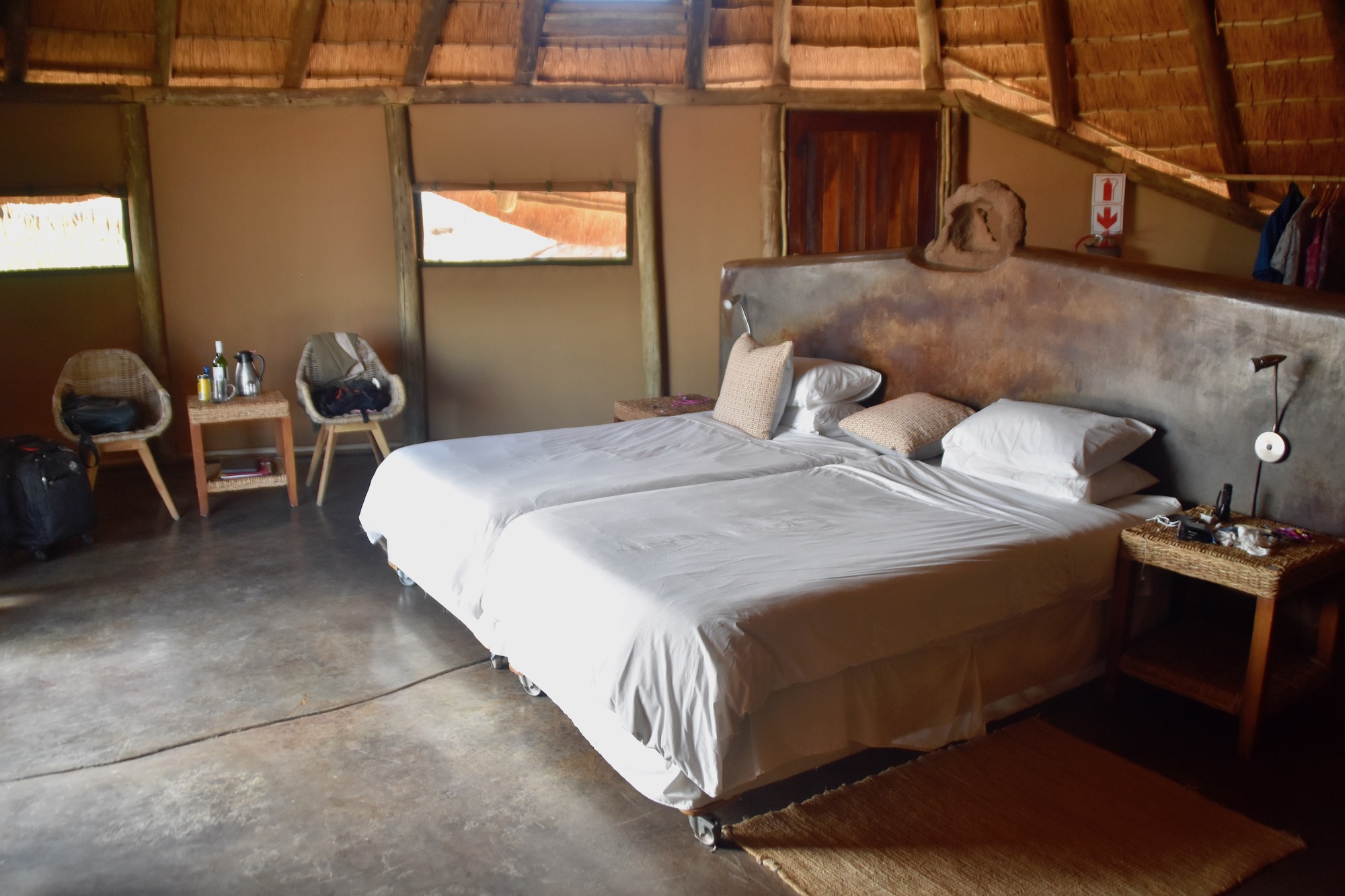
There’s both an indoor and an outdoor shower and a swimming pool so there are lots of ways to cool off in the late afternoon heat, which is intense.
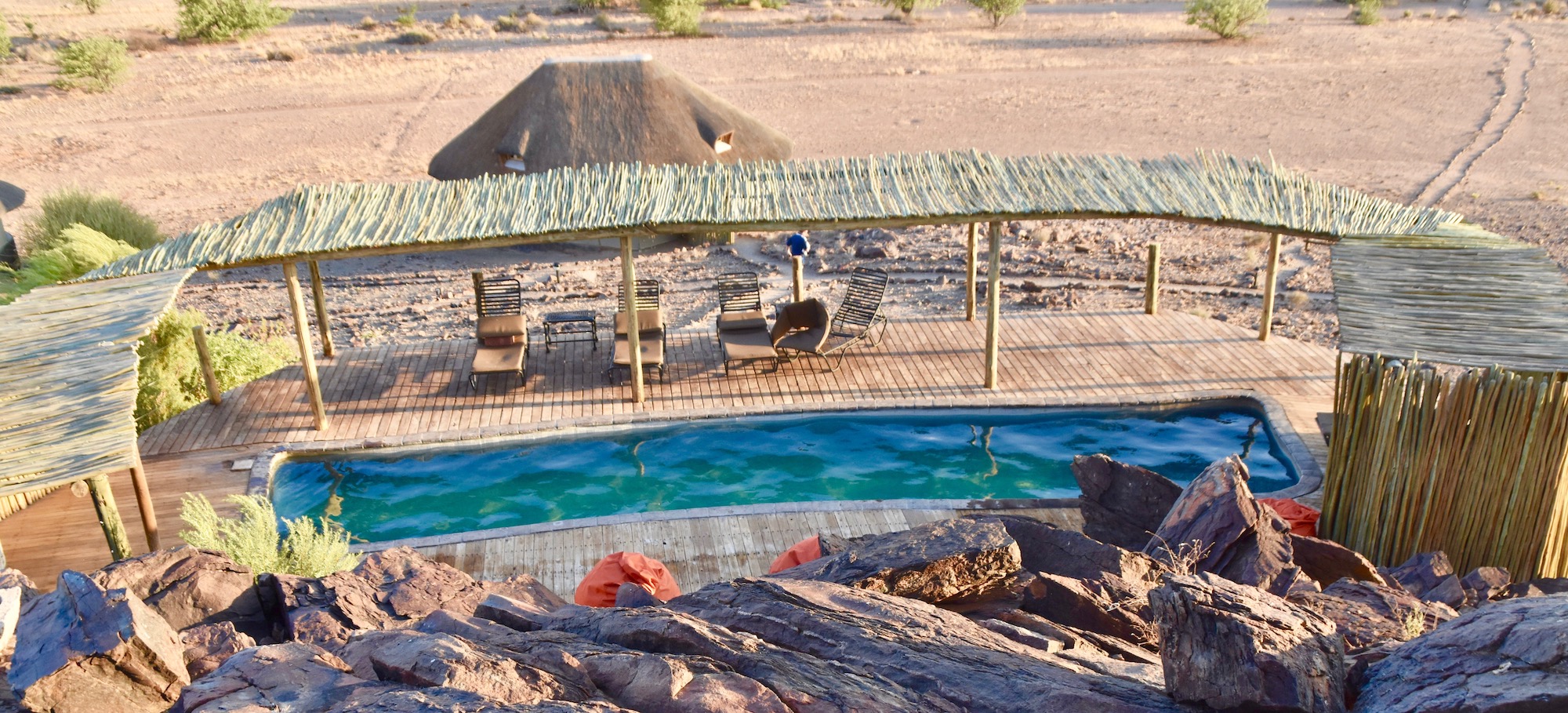
There’s also a very nice verandah from which to watch the sun go down and then wait for the myriad of stars to create the starlight which for thousands of years was what the vast majority of humanity saw at night. Now it’s the opposite. Seeing the night sky unobstructed by artificial light is a rarity for most and believe me, worth the effort to come to a place to see it. Doro Nawas is such a place.
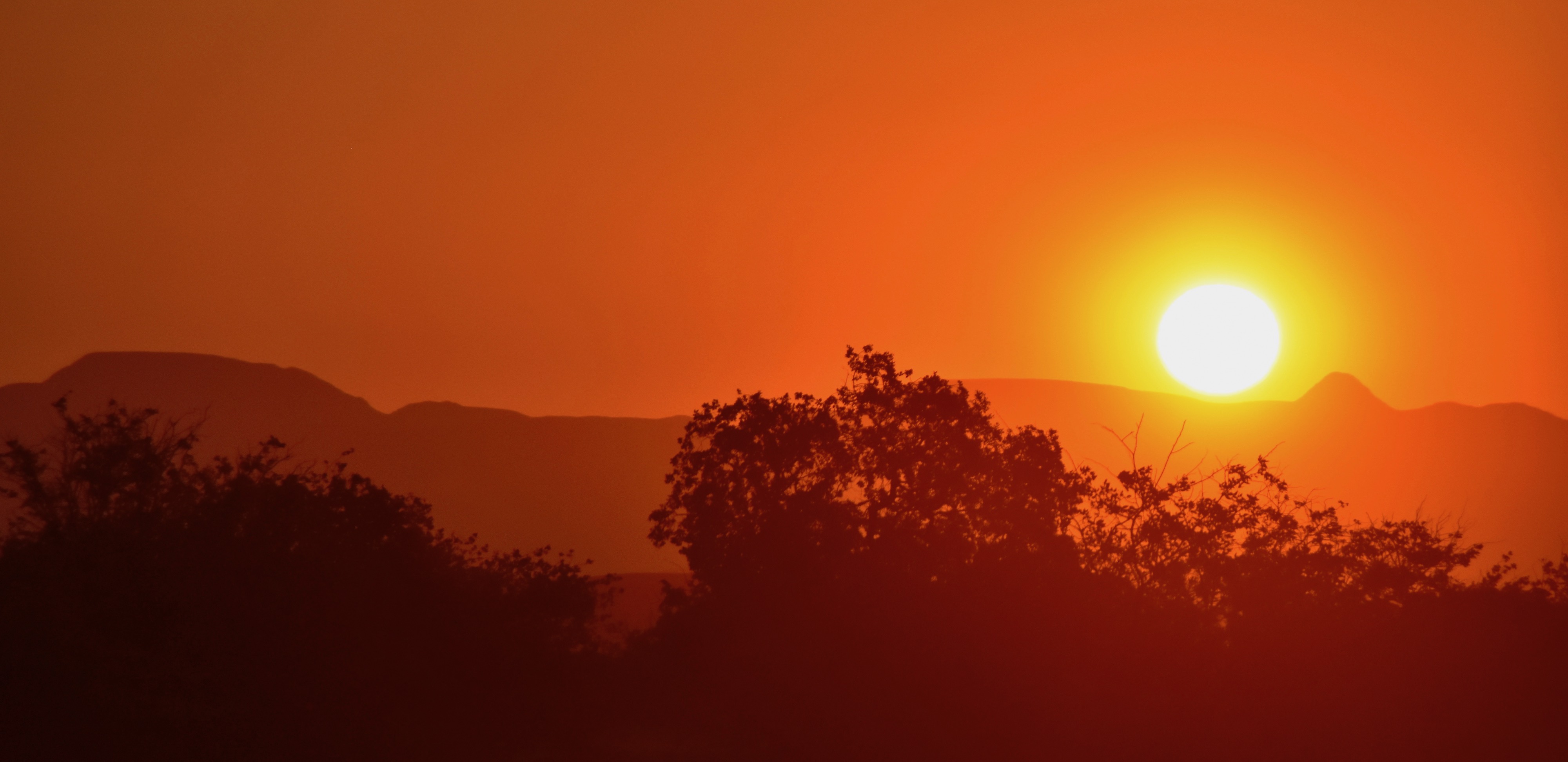
Searching for Damaraland Desert Elephants
The next morning we are all up early in eager anticipation of what this day has in store. The first half of the Namibian trip has not been what you would call a wildlife safari, but rather an exploration of some of the harshest environments on earth, especially the Namib Desert. We have seen wildlife for sure, but the sightings have been sparse and the number of species limited. That is about to change starting this morning as we will seek out the elusive desert elephants of Damaraland.
There is only one species of large African elephant, Loxodonta africana, but they live in such varied environments across the continent that they have developed distinct body types and behaviour that, before the definitive evidence of DNA, convinced some scientists that there were separate species of which the desert elephant was believed to be one. Desert elephants are only found in Namibia and thousands of miles north in Mali. They have made specific adaptions to a much dryer and less food rich environment than their savannah and forest cousins. Physically, desert elephants have longer legs and a smaller body mass than elephants that don’t need to cross sand dunes to find food and water. Because their diet is not as diverse or rich as other elephants their tusks tend to be smaller and brittler, fortunately making them a less valuable target for ivory poachers. They are also much less destructive to their environment, seldom knocking down whole trees to get at the upper leaves as forest elephants do. And of course, they can go for longer periods without water than their east African brethren.
There were once up to 3,000 desert elephants in Namibia, but that number is now down to about 600, but the good news is that that number has stabilized and even may be growing as Namibia has gotten very serious about elephant conservation. So we hop into our two Land Cruisers with guides Perez and Gerhardus and start our search for Damaraland desert elephants.
You’d think something as large as an elephant would be easy to find, but desert elephants travel in smaller herds than those further north in the Chobe region and they move around a lot, covering many miles in a day. Perez estimates our chances of finding them today as 50/50. He and Gerhardus join a local guide in a conference on where to start looking. As you can see the elephant tracks are hard to miss so they know the elephants have recently been in the area.
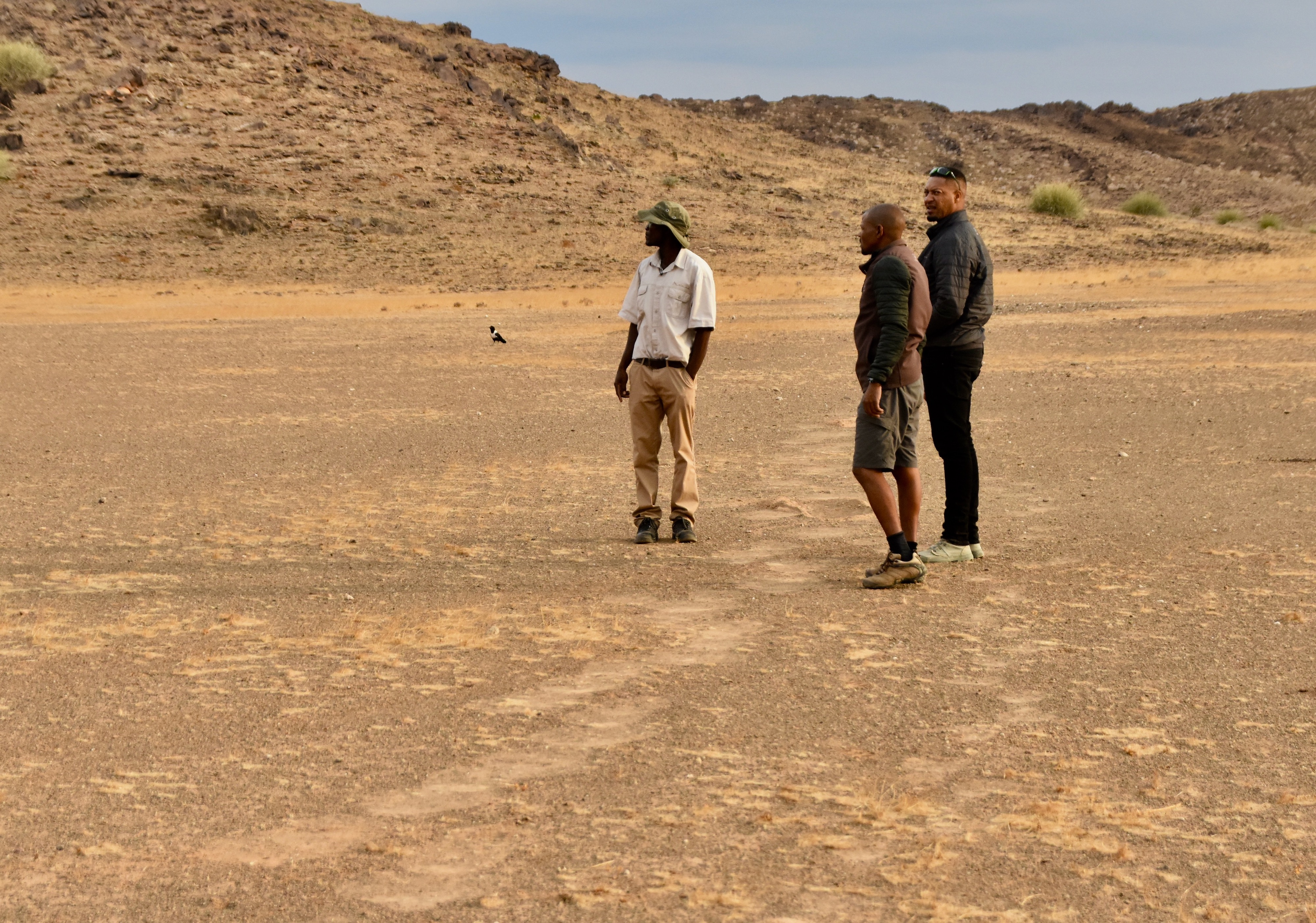
The first thing they find is this rather gruesome corpse of a dead red hartebeest. Perez explains that in Damaraland and other arid parts of Namibia, corpses do not end up as a set of bleached bones picked clean by scavengers, but rather they desiccate like this one. Over the next few days we were to see many other examples like this. The guides are not able to say what killed this creature – it could have been lions, a leopard or hyenas.

The elephant tracks head up and over a rocky ridge which only a vehicle like a Land Cruiser could navigate. We all get out and climb to different points on the ridge to see if we can spot the elephant herd, but there’s not an elephant in sight.
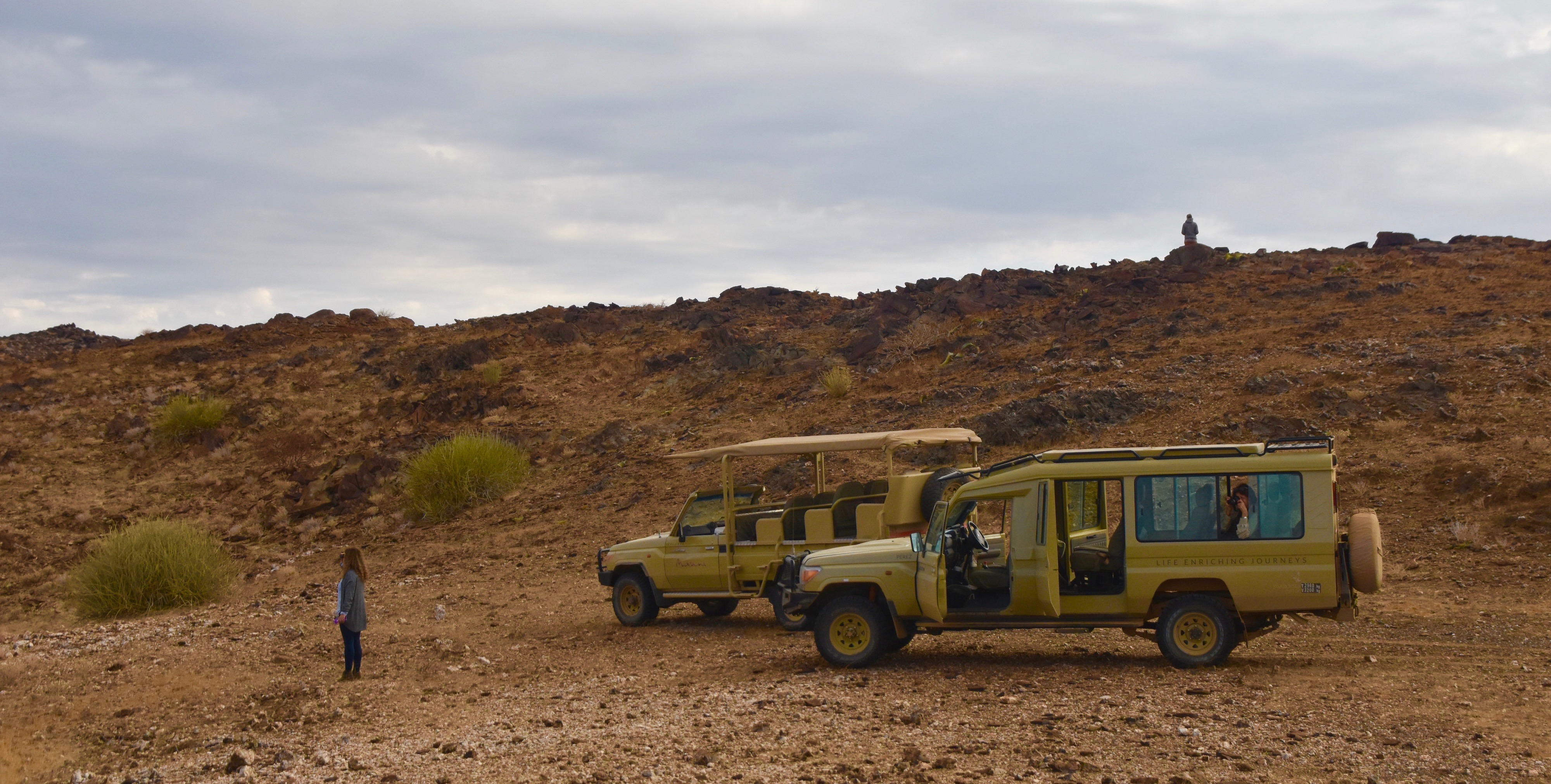
We do spot a steenbok, which is a first for me, but it’s a poor consolation. We’ve been out over two hours and I’m starting to think we might be on the wrong side of the 50/50 chance.
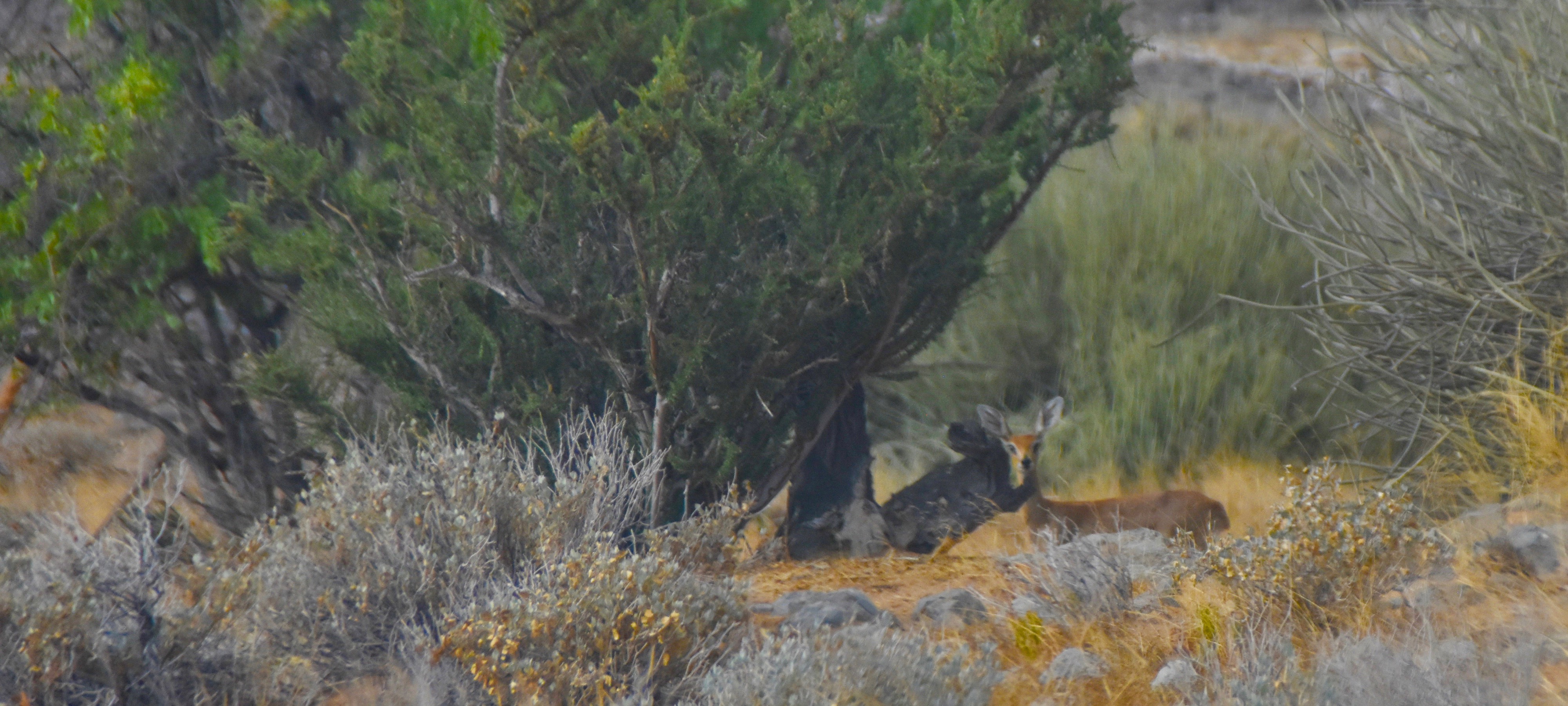
Perez and Gerhardus decide to change tactics and we head down from the rocky hills to an ephemeral river bed which is completely dry, but compared to where we’ve been looking, a veritable oasis of vegetation. And then, just like that, there they are. These two brothers, elephant teenagers, were chowing down on the leaves of an acacia tree not bothered by our presence in the least. The tops of the Land Cruisers have been lifted up so we can stand and photograph them without the obstruction of glass in between us. The rules are simple for this type of animal viewing and they would apply even if this were lions, a leopard or hyenas. Keep yourself totally inside the vehicle and be quiet. This way the animals apparently have become used to these huge mechanical beasts coming up close to them and know that they are neither a threat or their next meal.
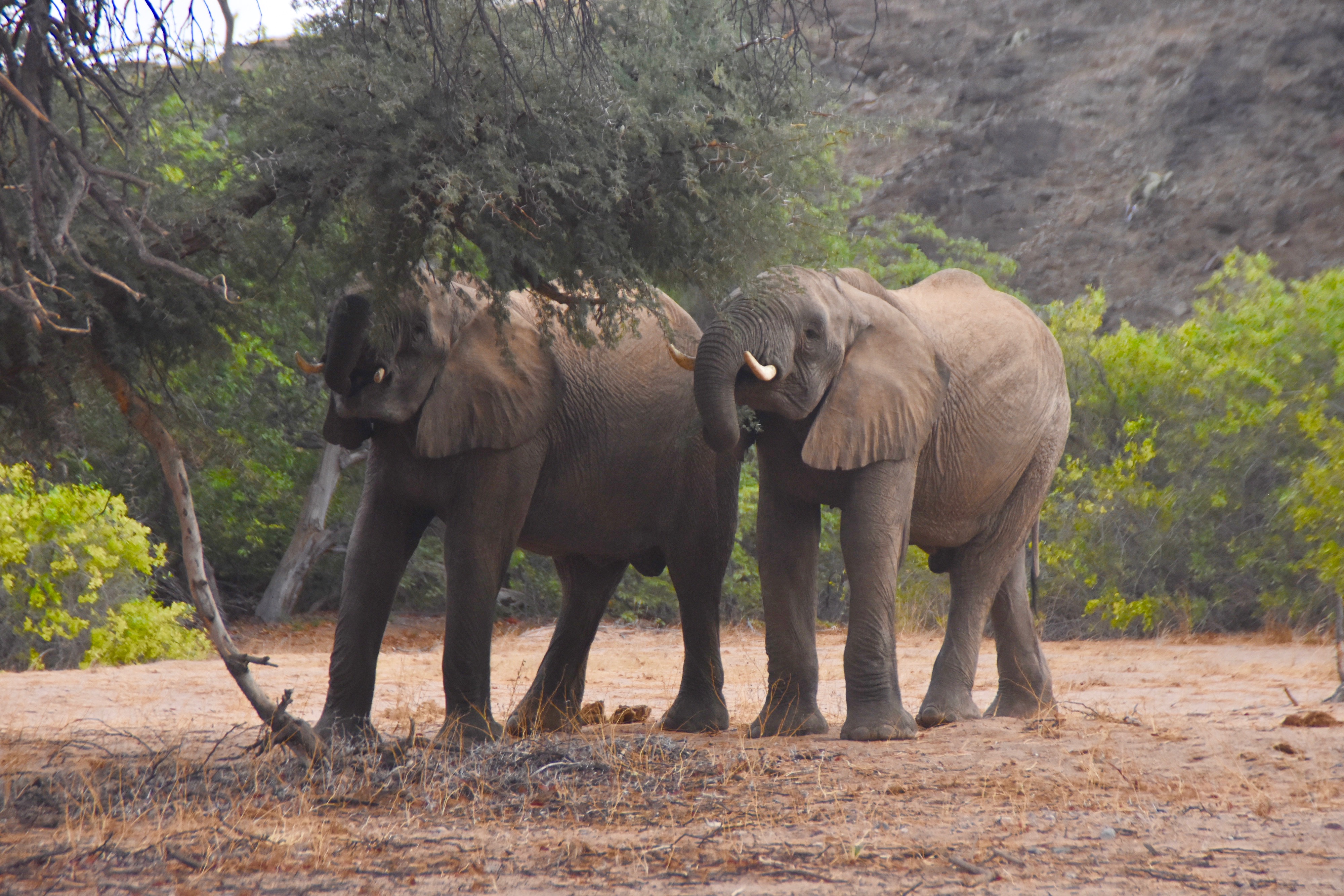
From now on the elephants come on at a steady pace in small groups like this mother and child.
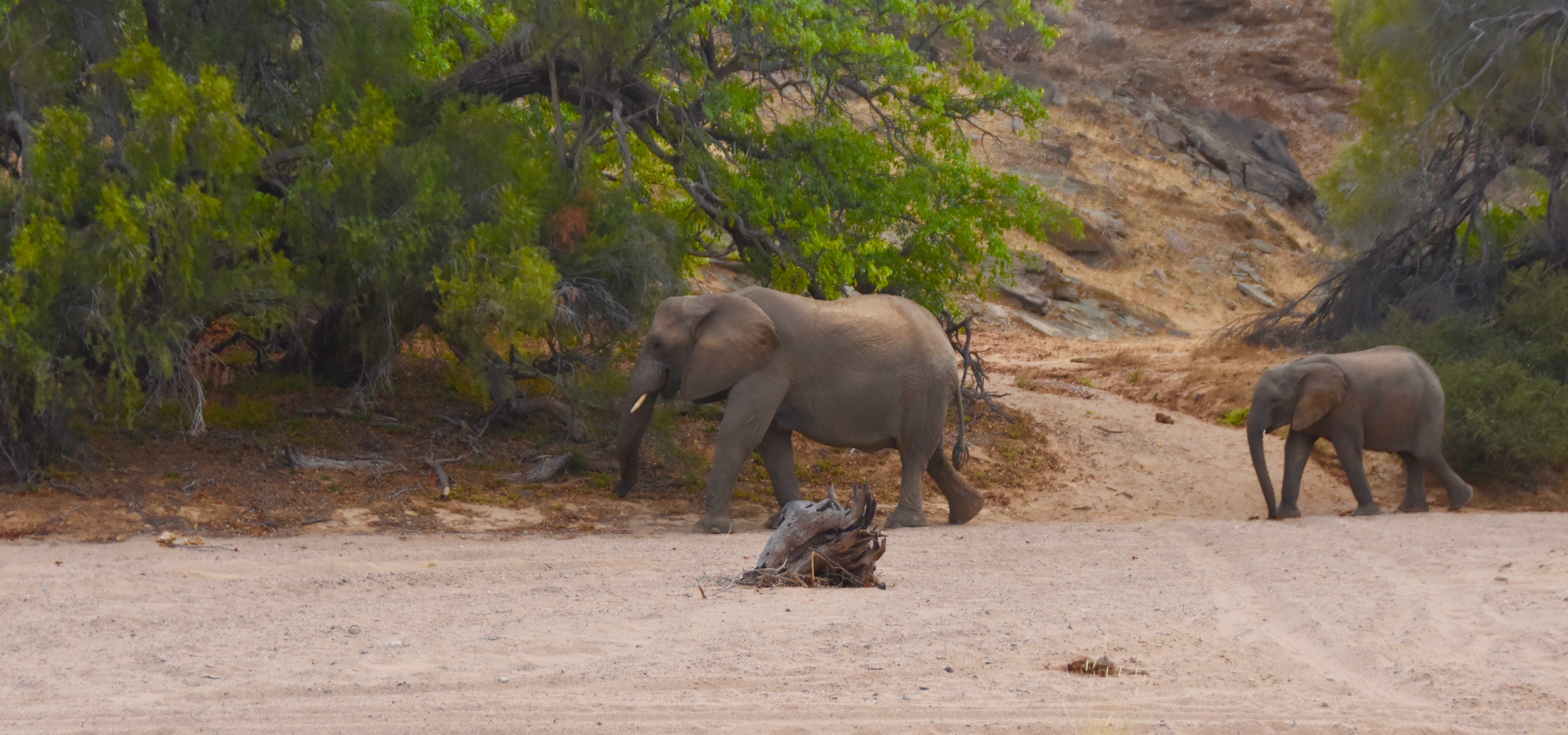
These two indulged in playing a game of ‘I’m the king of the castle’. One would get the higher ground on the riverbank and try to push the other one off. When he succeeded the other one would try to sneak up from another path, but the other guy would be there waiting for him. It was very amusing to watch and made me realize how much elephants are like humans in how we both grow through stages from helpless baby, inquisitive child, bratty teenager, young adult, full maturity and eventually, dotage. Sitting in the Land Cruiser not 30 feet away from these magnificent creatures I could not comprehend that anyone would ever want to kill one for ‘sport’.
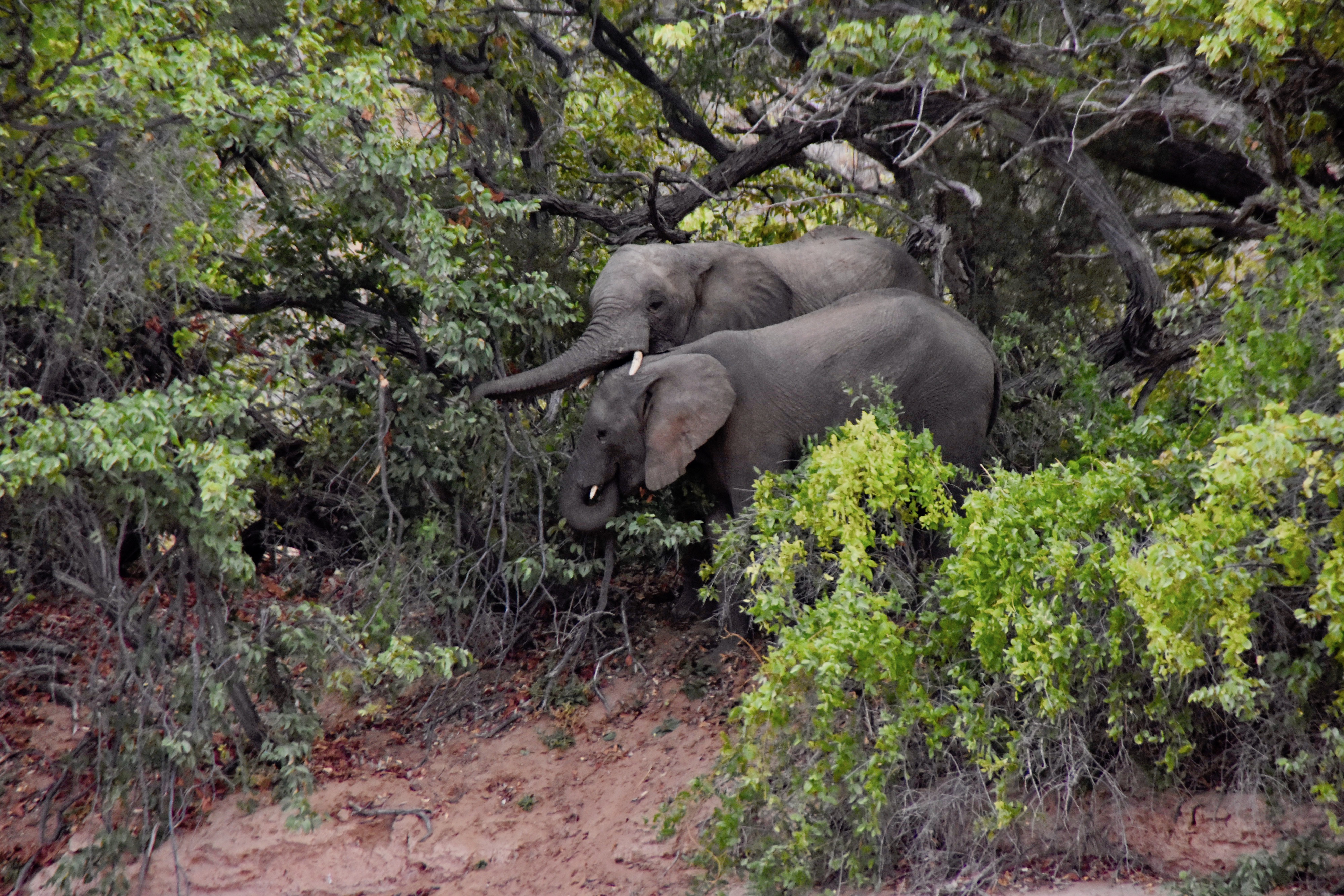
Two more young elephants joined the game and it became a real shoving contest with surprisingly, the smaller of the four holding his own against the others.
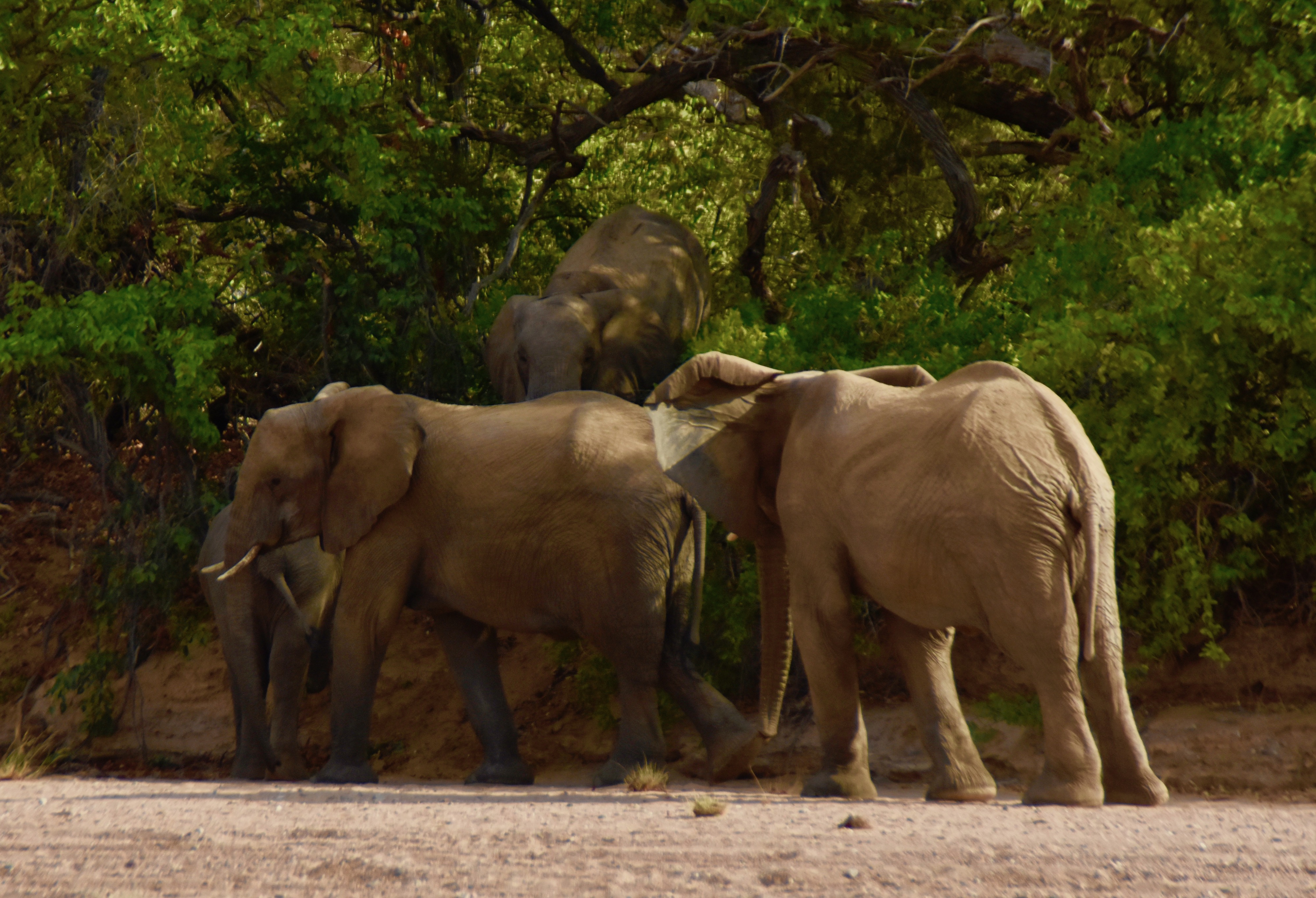
After about thirty minutes we reluctantly moved on and came across this large bull not far away. The guides identified him as being quite old and probably on his own after being ousted as the alpha male by a younger rival.
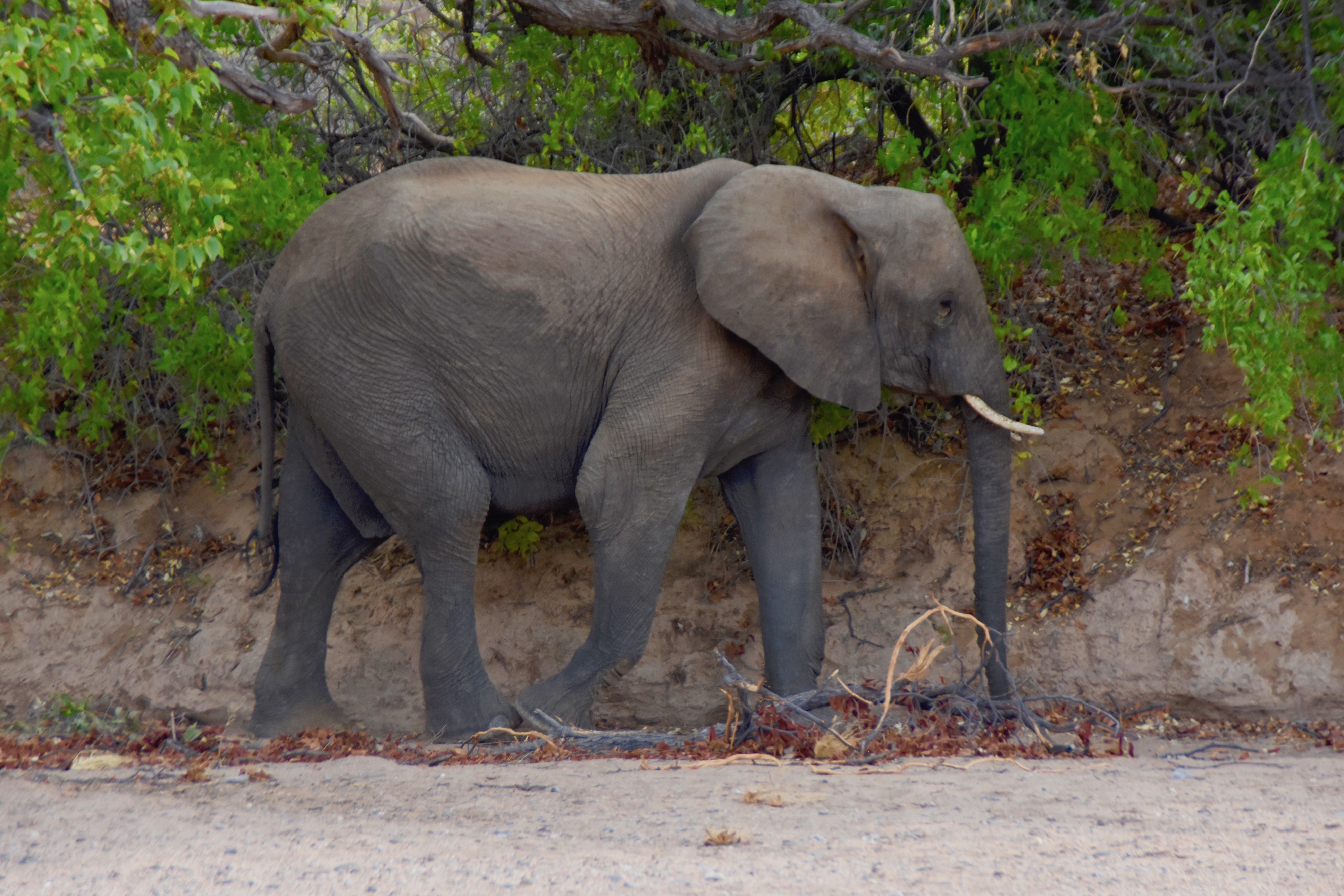
As was becoming our practice, we stopped for lunch under the shade of a large tree, in this case a beautifully gnarled old black-thorn acacia.
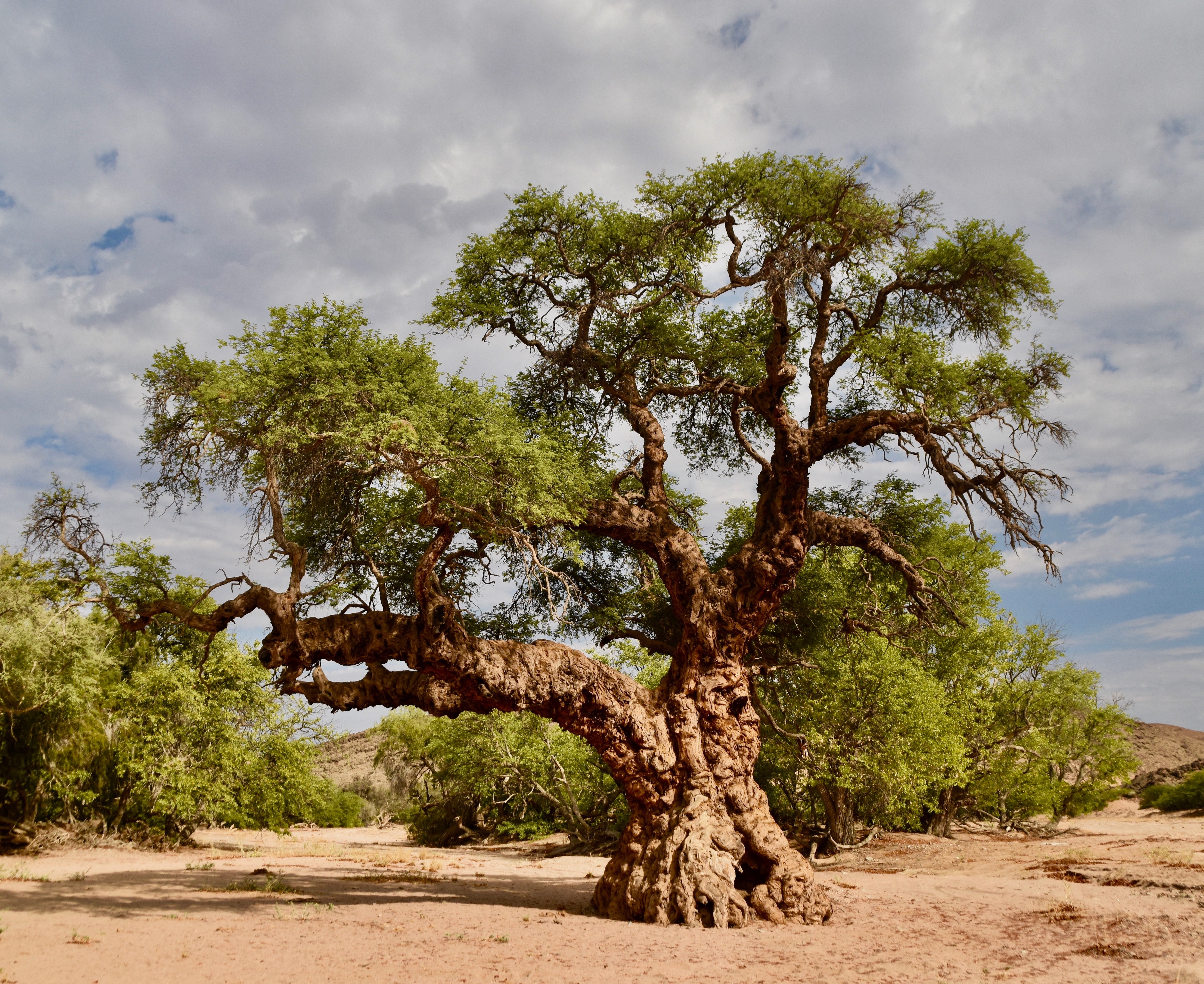
After lunch we resumed our photo safari with Perez driving at a very high speed along the flat desert surface and then hurtling the Land Cruiser up what looked like an impossibly steep hill. It was a bit of an adrenalin shot, but he told me he had done it many times and it turned out to be worth it as we had this great panorama of Damaraland spread out below.
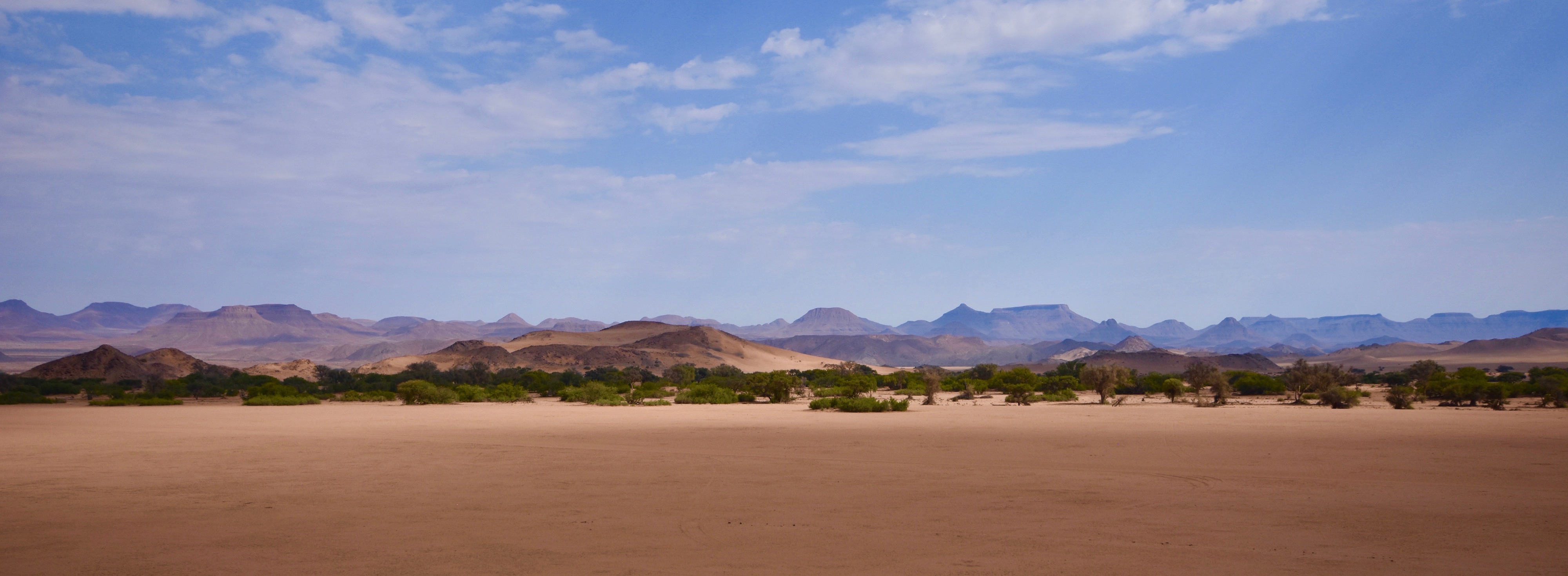
Most of the couples on the tour took advantage of this scenic stop to get their photos taken. This was ours and it gives a better perspective of how high up we were over the valley below.
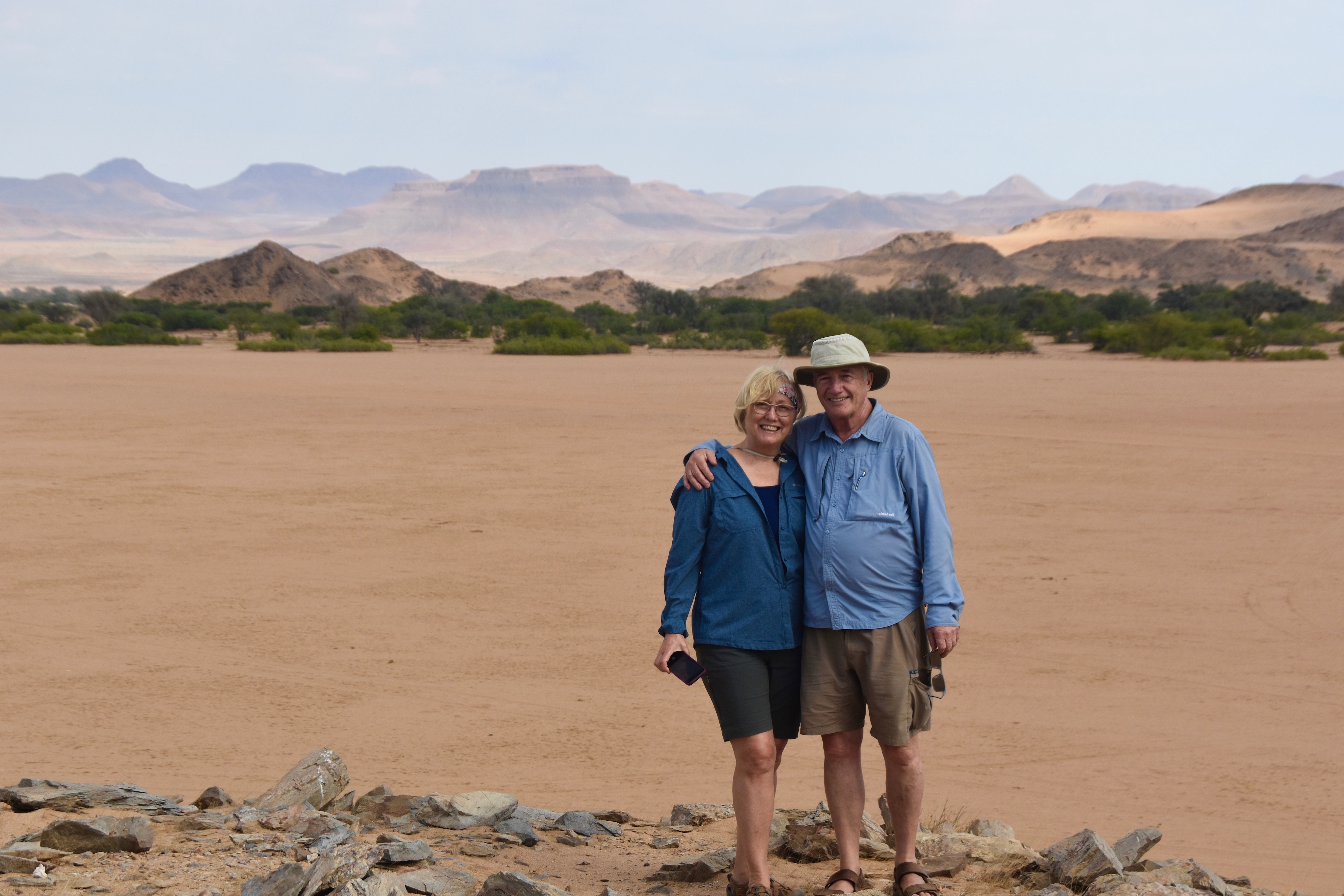
From this aerie we could a number of ostriches in the distance, but little else on the arid plain below so Perez tried a different tactic, deciding to head for another dried riverbed he knew was often frequented by desert elephants. Along the way we passed this small village which was typical of many we saw in Damaraland.
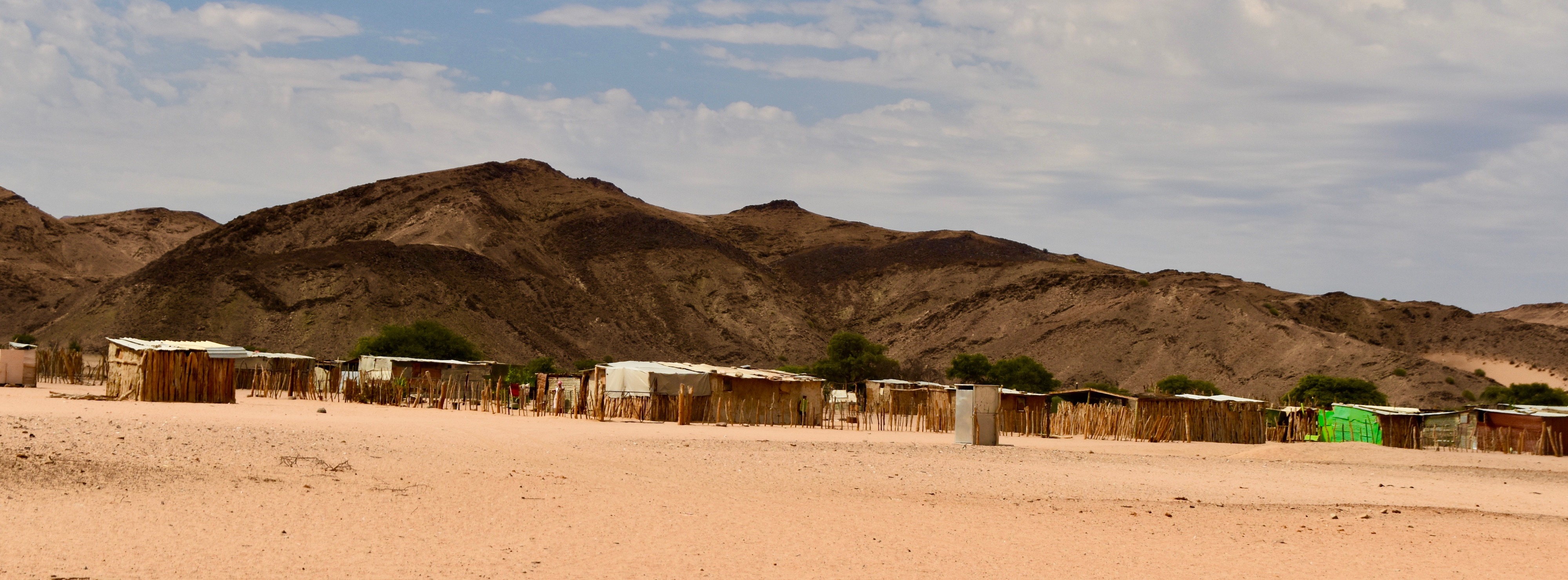
It looks to be a rough existence out here in the searing heat without electricity or running water, but just over a century ago that was the way most rural North Americans lived, including my mother’s side of the family in the Annapolis Valley. They were farmers, as are these people, and who am I to say they weren’t just as happy with their lot in life as we think we are today. Believe it or not people can live life without smart phones and the internet or even electricity and still be happy. Poverty is a relative thing. If people were living like this in Canada we would think it was terrible and we had to do something about it. In much of Damaraland, this is the way of life and nobody is demanding that they be moved into public housing with running water. electricity and a big screen TV ‘for their own good’.
OK, that’s my rant for this post.
For the next hour or so we start seeing all kinds of birds amid the trees that have now reappeared, many of which I have never seen before like this fairly rare Ruppell’s parrot. When people think of parrots they usually think of jungle, but they do exist in a wide variety of habitats.
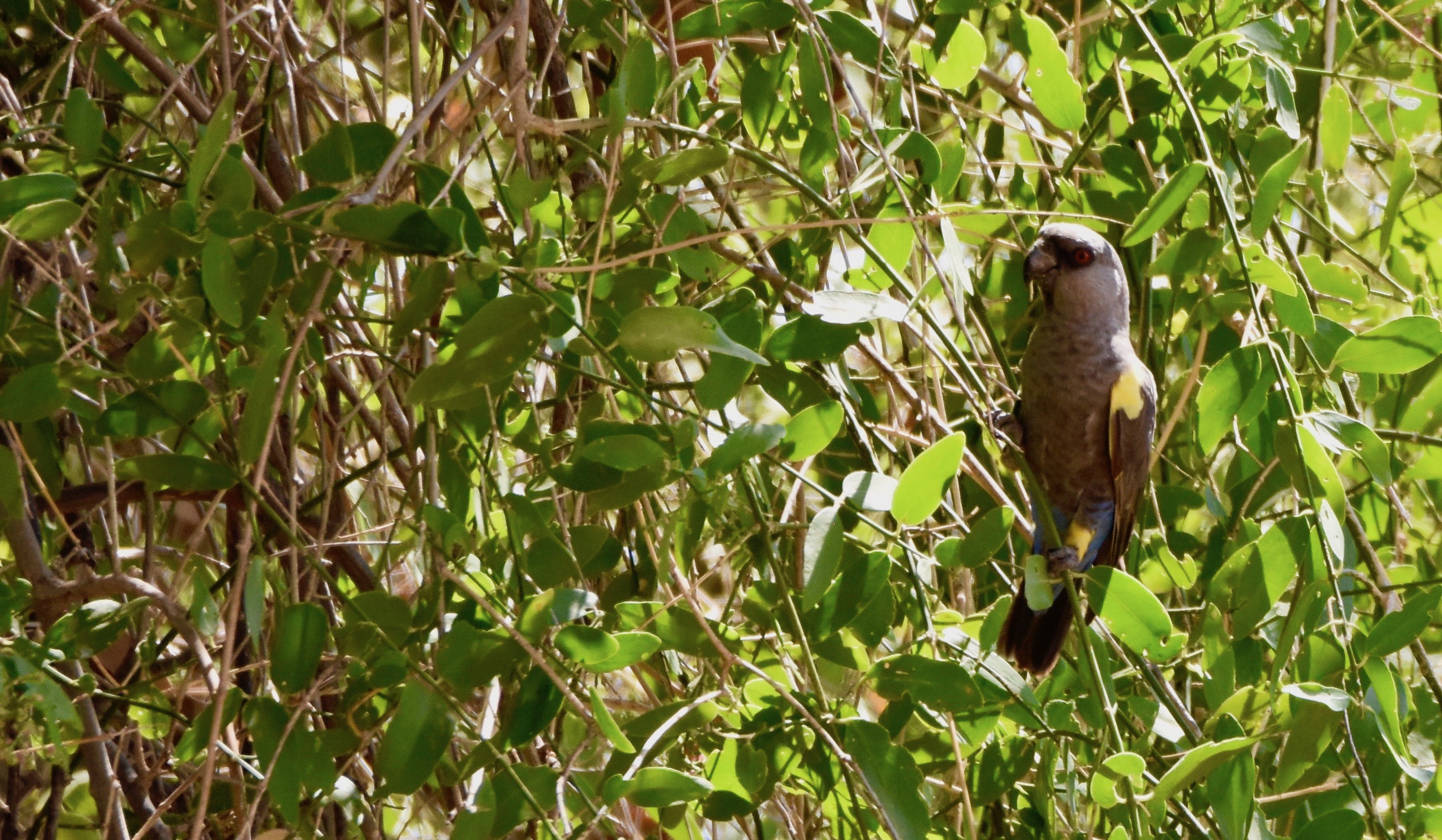
Much more common are these Go Away Birds, members of the turaco family. They are called this because they act as natural sentinels for other animals. They sit high in the trees and the moment they spot a potential predator they create a racket that warns all potential prey to get the hell outta there.
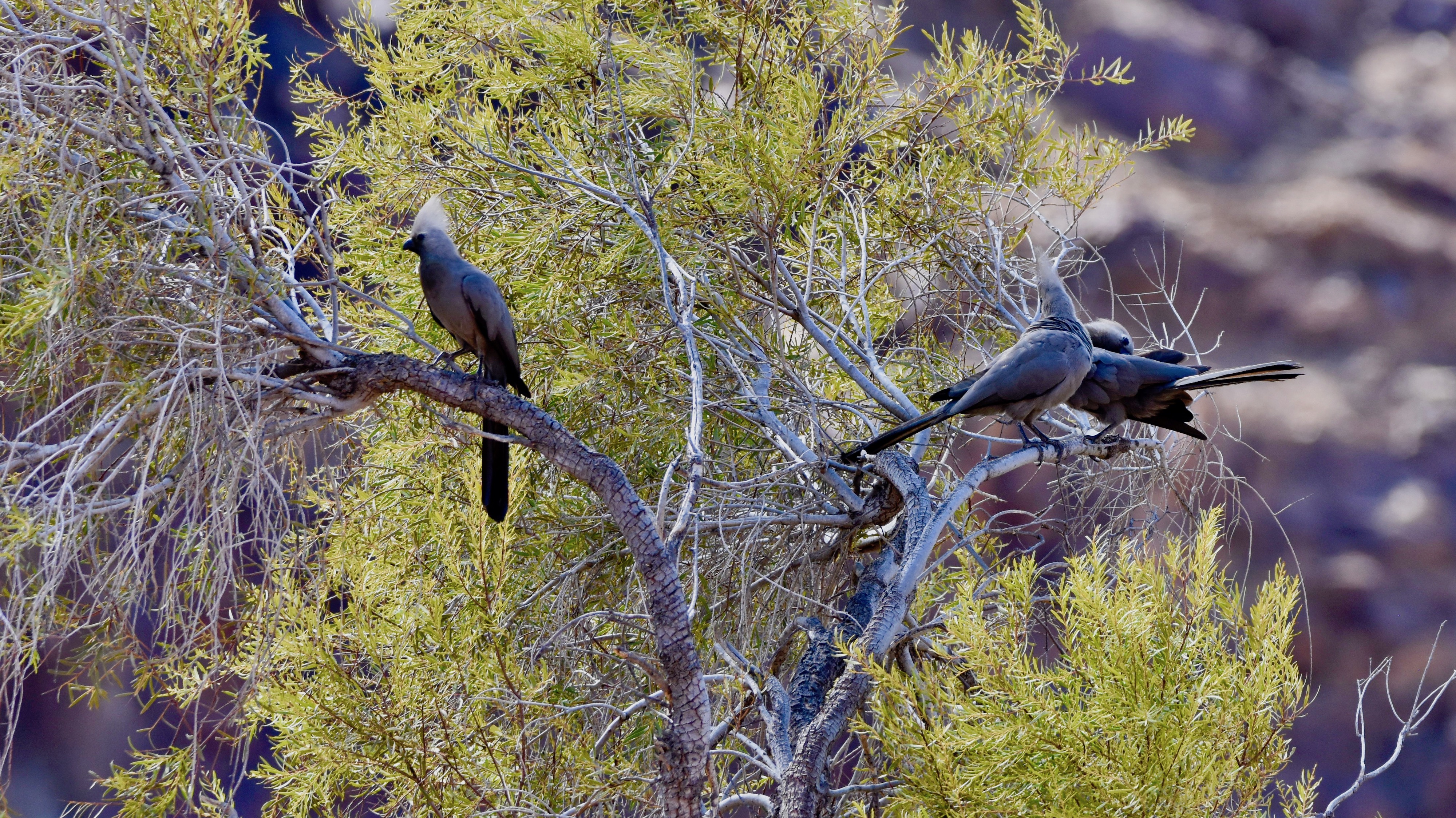
Also common, but always fun to see are hornbills of which Namibia has a number of species. This is the African Grey Hornbill.
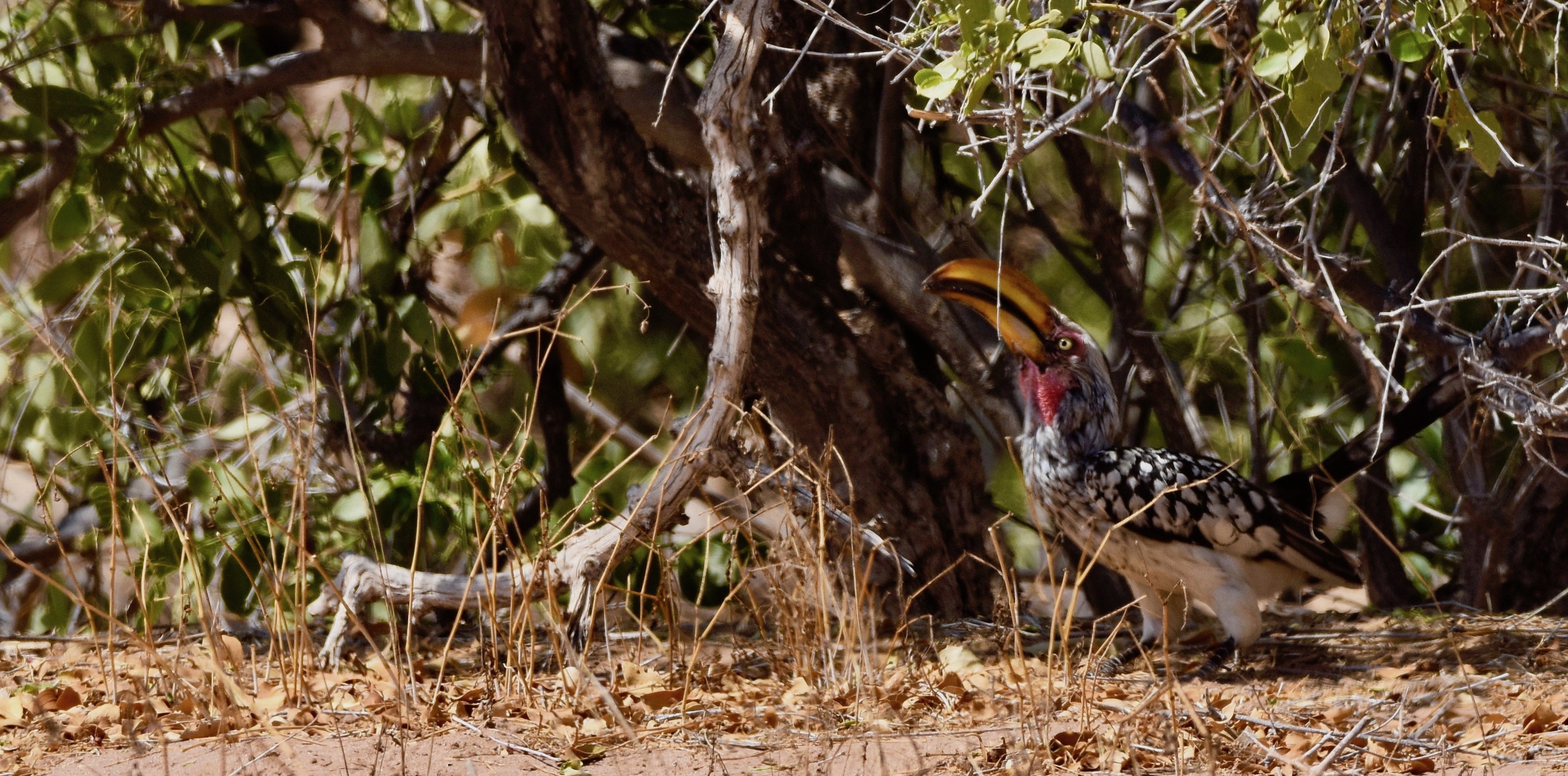
Perhaps the most common of the larger ground birds in Damaraland is the Red-Billed Spurfowl which is quite unafraid of human company and goes about its business only a few feet from the Land Cruiser.
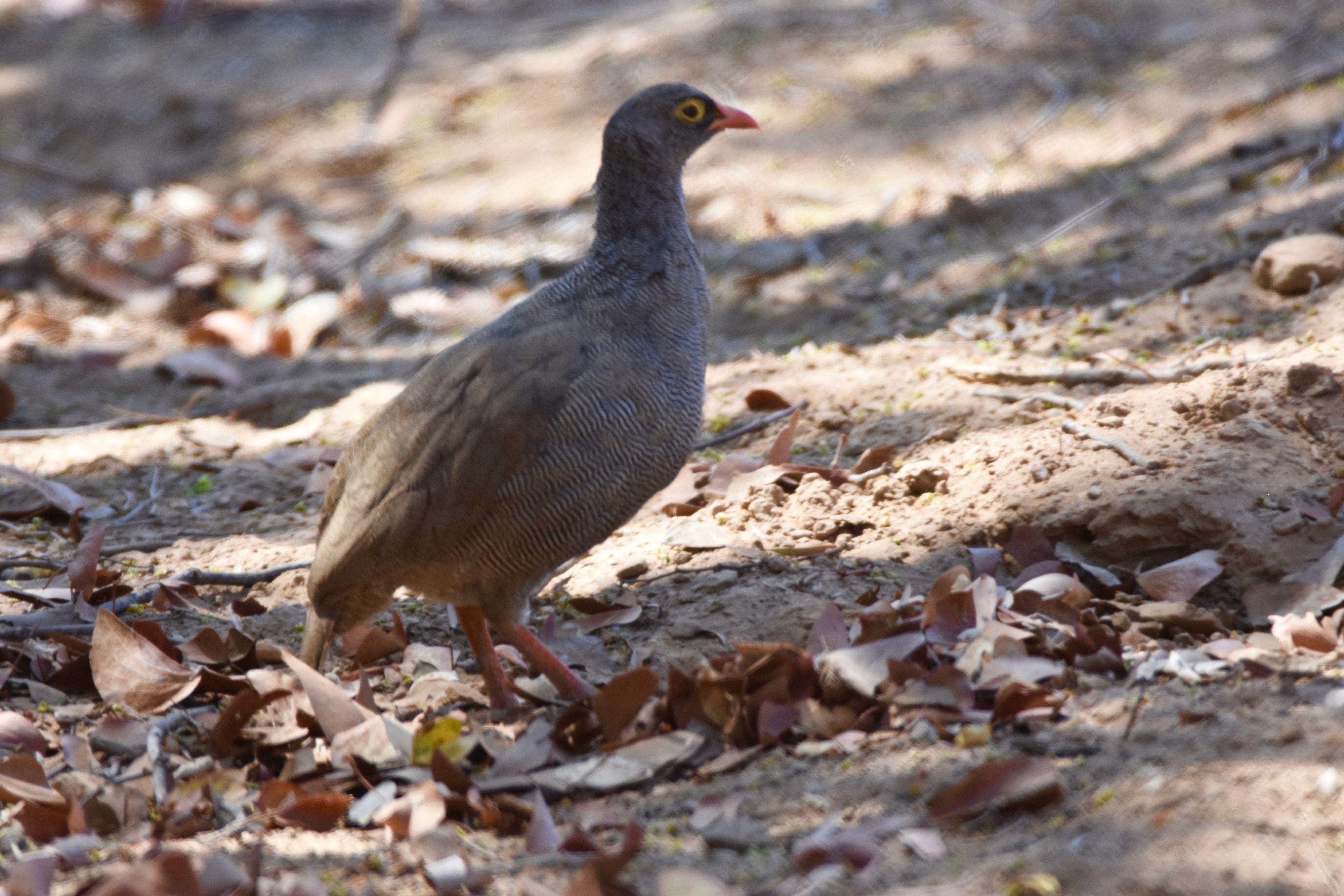
When people think of going on safari, they usually think of seeing big things like, well elephants, rhinos, hippos, giraffes etc. and dangerous things like lions, leopards, hyenas and crocodiles. They don’t usually think of birds, yet for me at least, the birds are just as interesting as anything you’ll see in Africa. Their fantastic variety of colours, songs, feeding techniques, let alone their shapes and sizes, makes them more than worthy of your full attention.
But just as I was waxing on about the virtues of birding to anyone who would listen, “Bam!” we come across something that is truly amazing. My first thought is, “OMG, it’s two dead elephants.”, but Perez quickly assures us that they are just having an afternoon siesta.
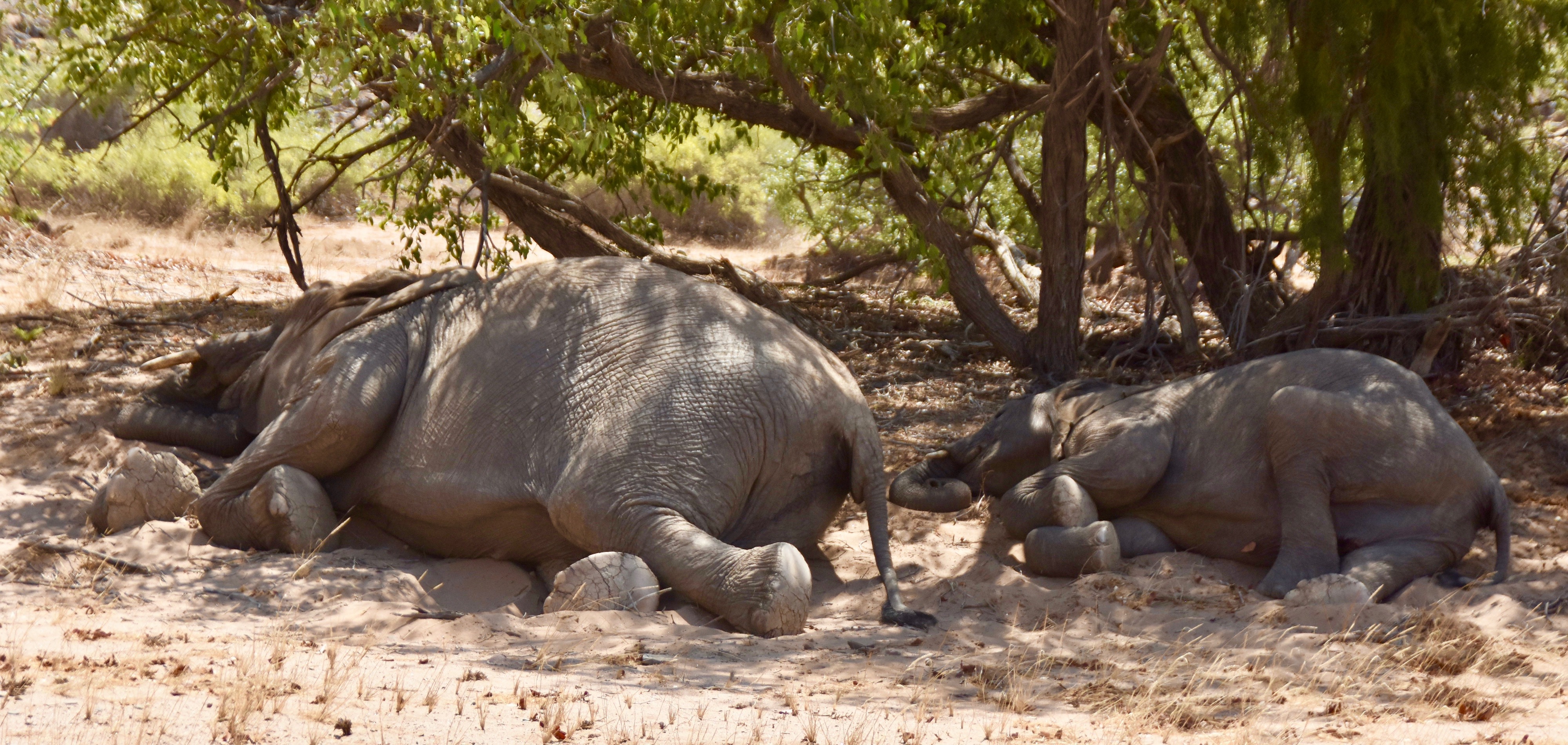
I’ve seen lots of elephants in my time, but what seems strange in retrospect, never seen one sleeping before. This photo does not really show that the elephants are sleeping on a slope of the riverbank. Apparently they must sleep at an angle or they can’t get up. You learn something new everyday.
Further down the riverbed other elephants are on the move including this very young one. You can see from this photo just how close up to the elephants you can get in Damaraland. However, at no time did I feel we were harassing them or changing their natural behaviour. They just went about their business and ignored us.
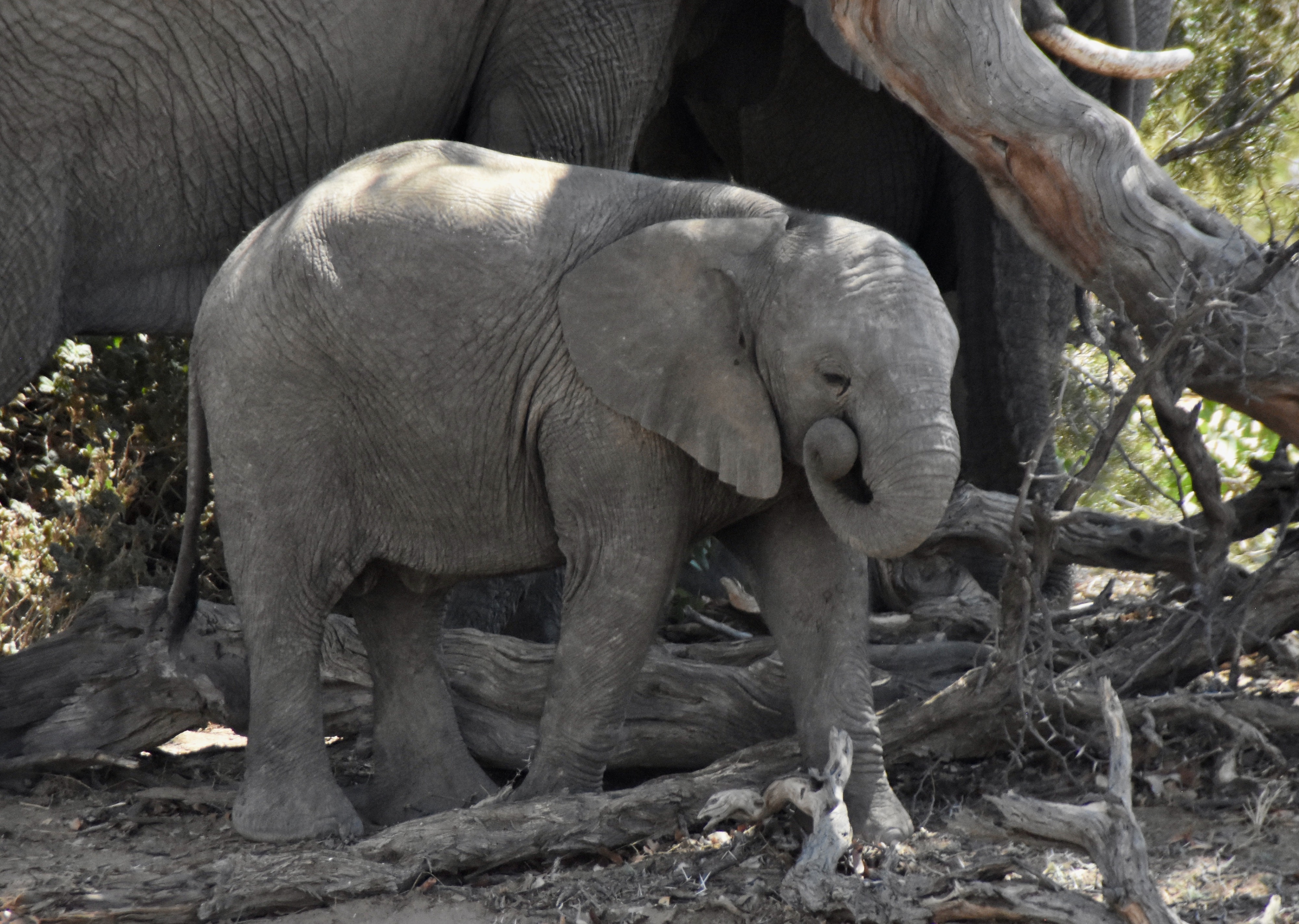
One last elephant photo and we’ve got to be getting back as we’ve come a long way from Doro Nawas. This one shows a juvenile elephant using his trunk to scratch behind his ear, yet another use for that most versatile proboscis in the animal kingdom.
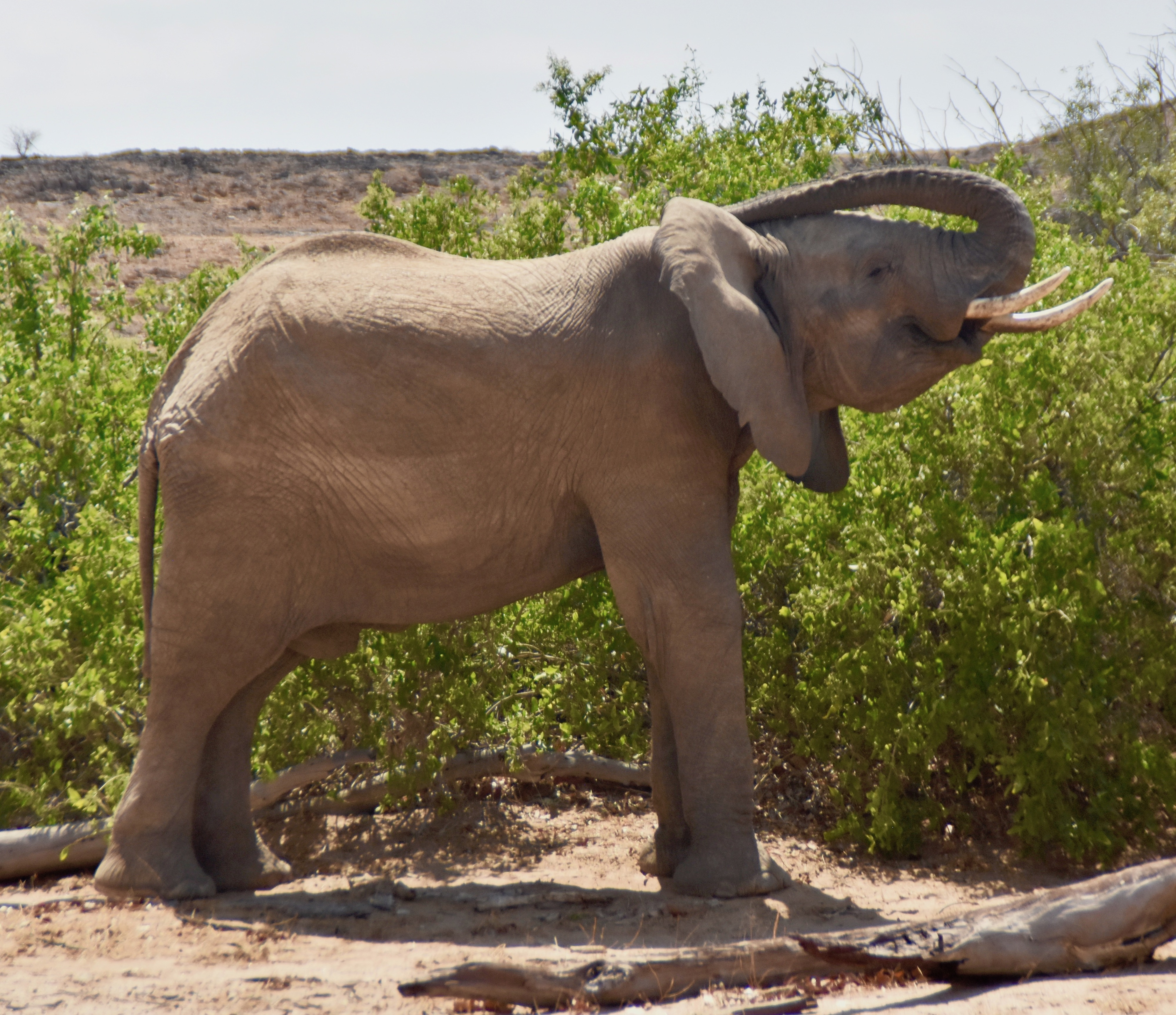
Just before reaching Doro Nawas we make one last stop, this time to view a plant instead of an animal. This is a female welwitschia mirabilis aka The Miracle Plant. It is the national symbol of Namibia, in fact the national rugby team is called the Welwitschias. It is a living fossil, being the only one in its genus, and one of, if not the longest, living things on earth. The average welwitschia is 500-600 years old and some specimens are believed to be over 2,000 years old. That really is a miracle. Imagine if you could splice some of these genes into your DNA? I’ll bet some rich megalomaniac will try it.
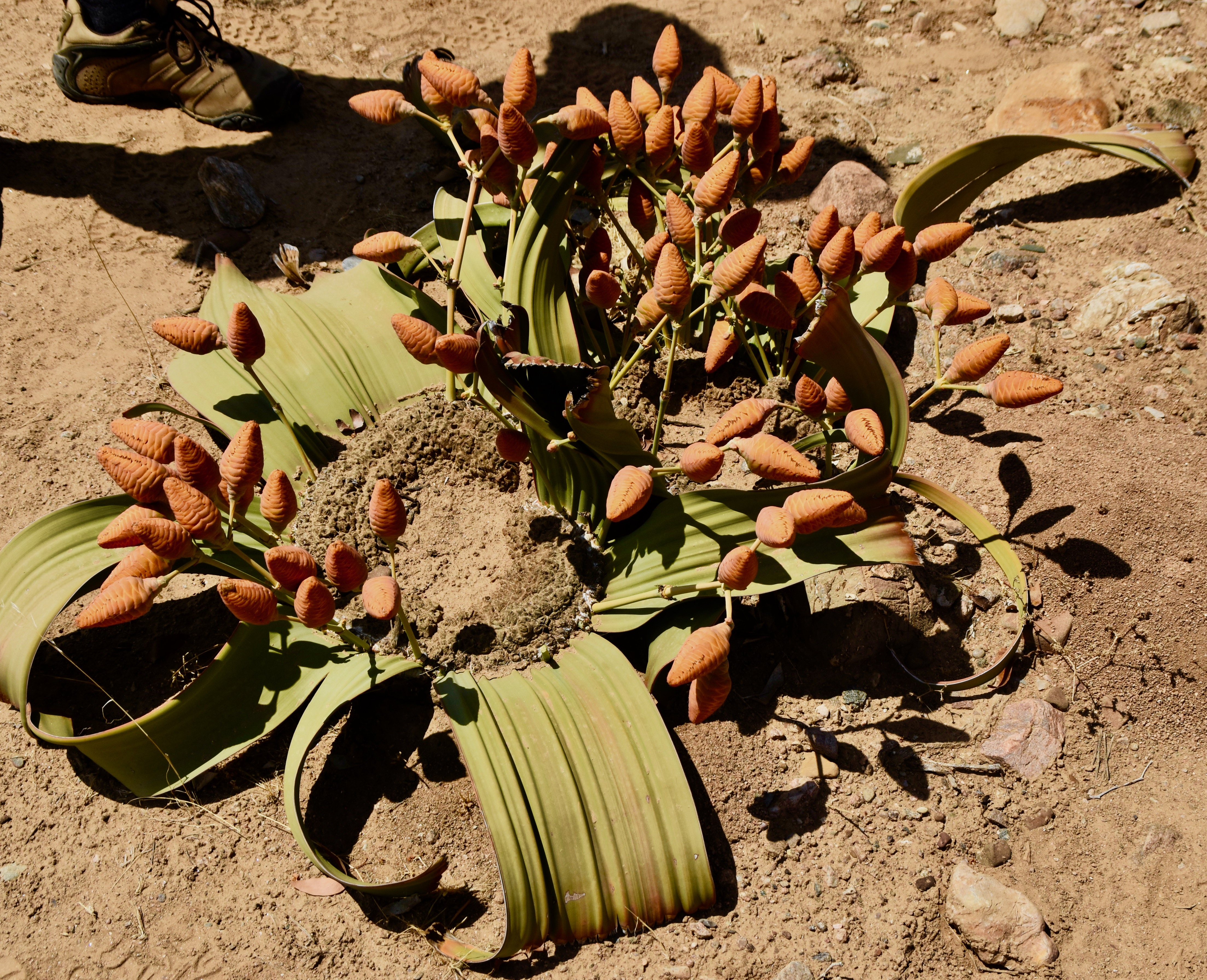
This is her husband living right next door.
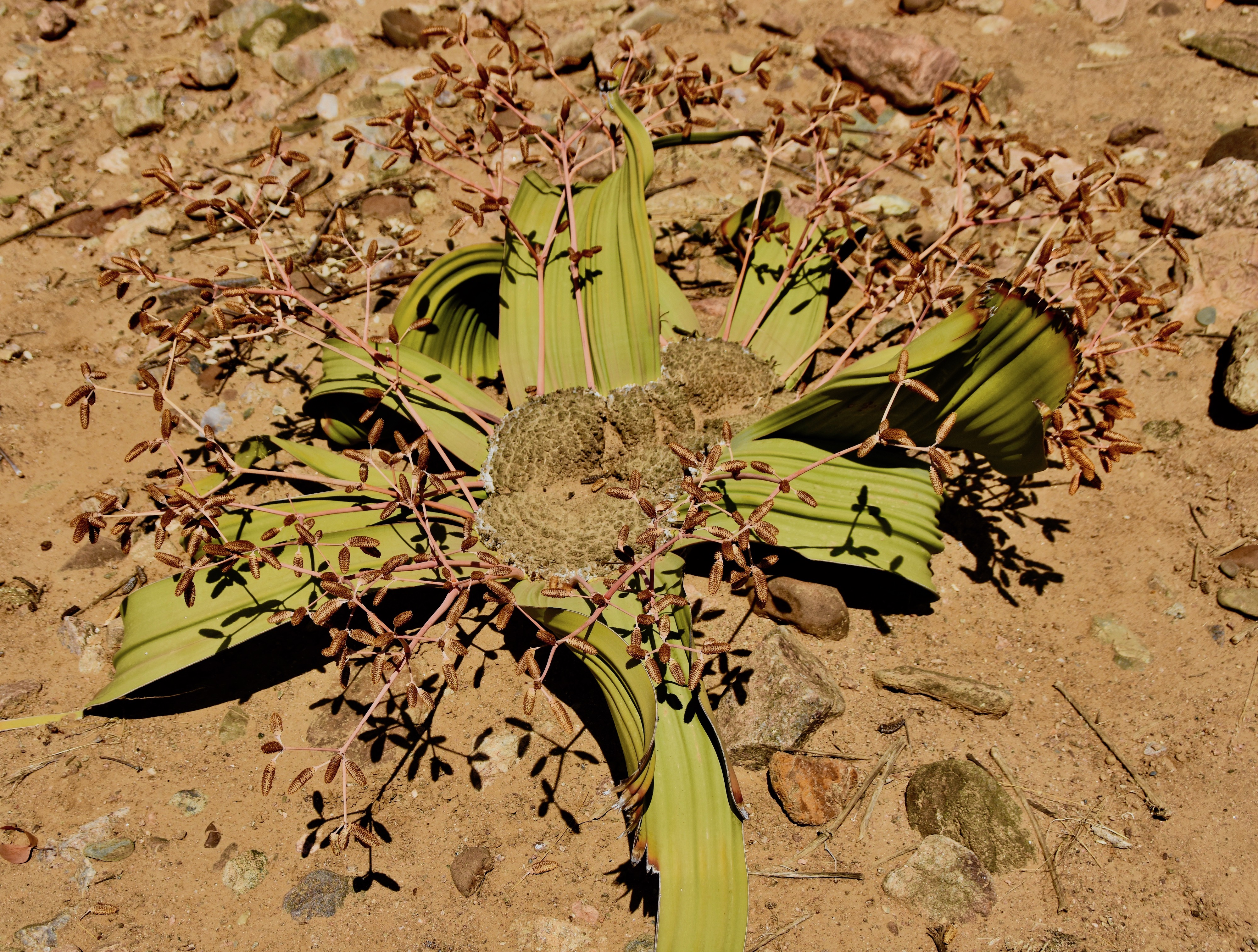
Back at Doro Nawas it’s nearing sunset and the staff has prepared an al fresco ‘bush dinner’ in an outdoor dining area below the main lodge.
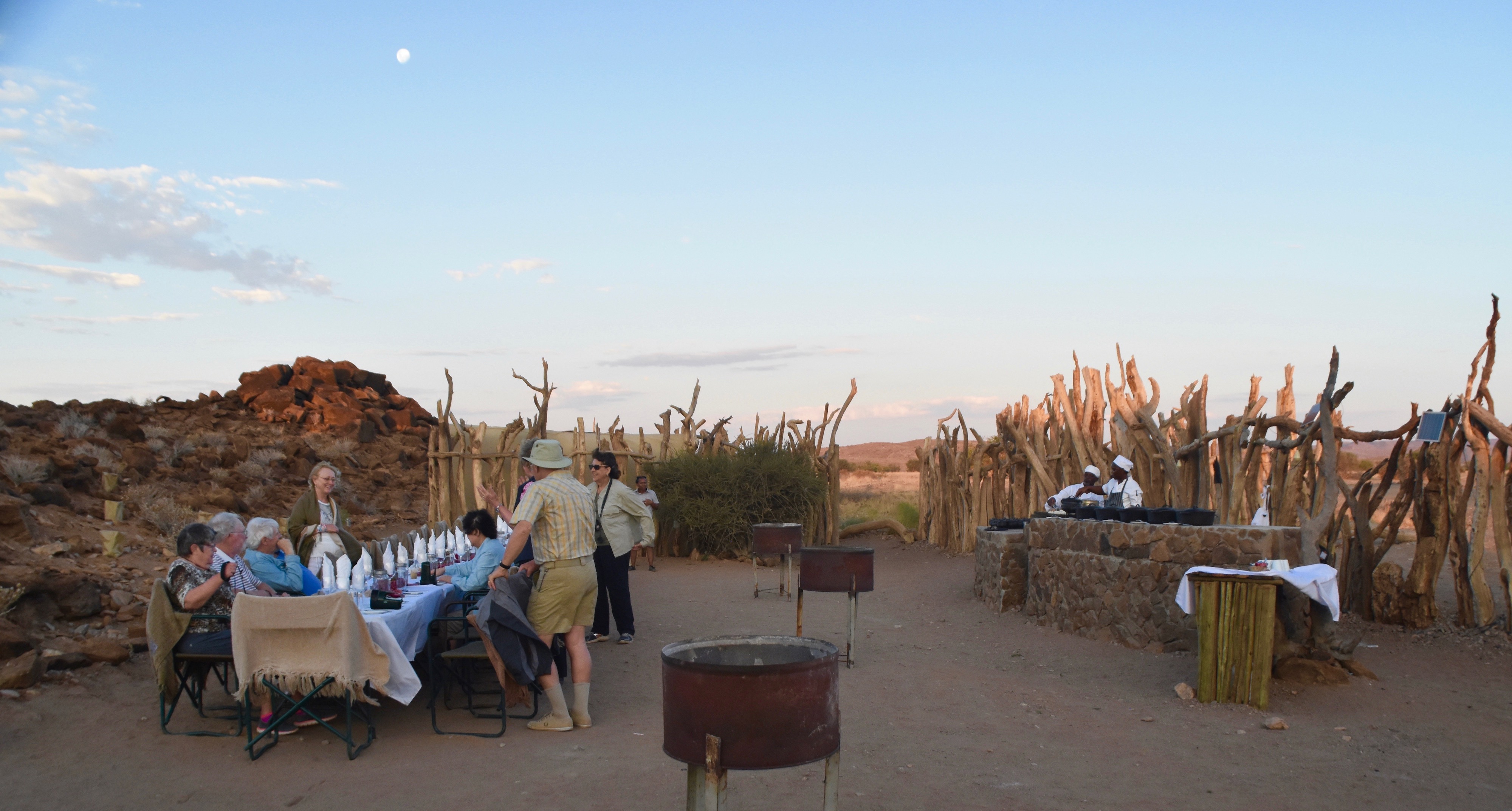
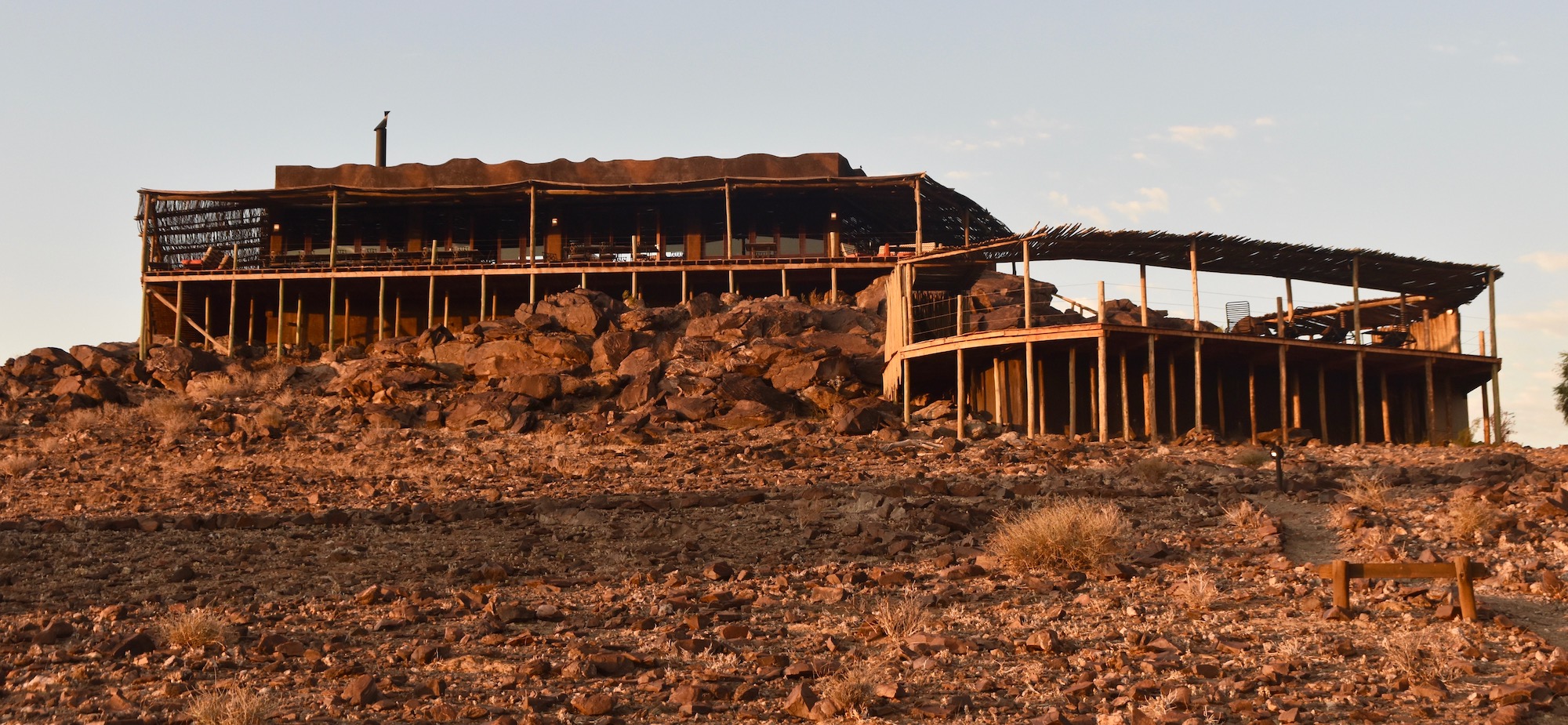
As the sun sets and we dig into a smorgasbord of meats, vegetables and grains washed down with beer and wine, dozens of lanterns are lit on the hillside creating a truly special effect and a great ending to a truly special day.
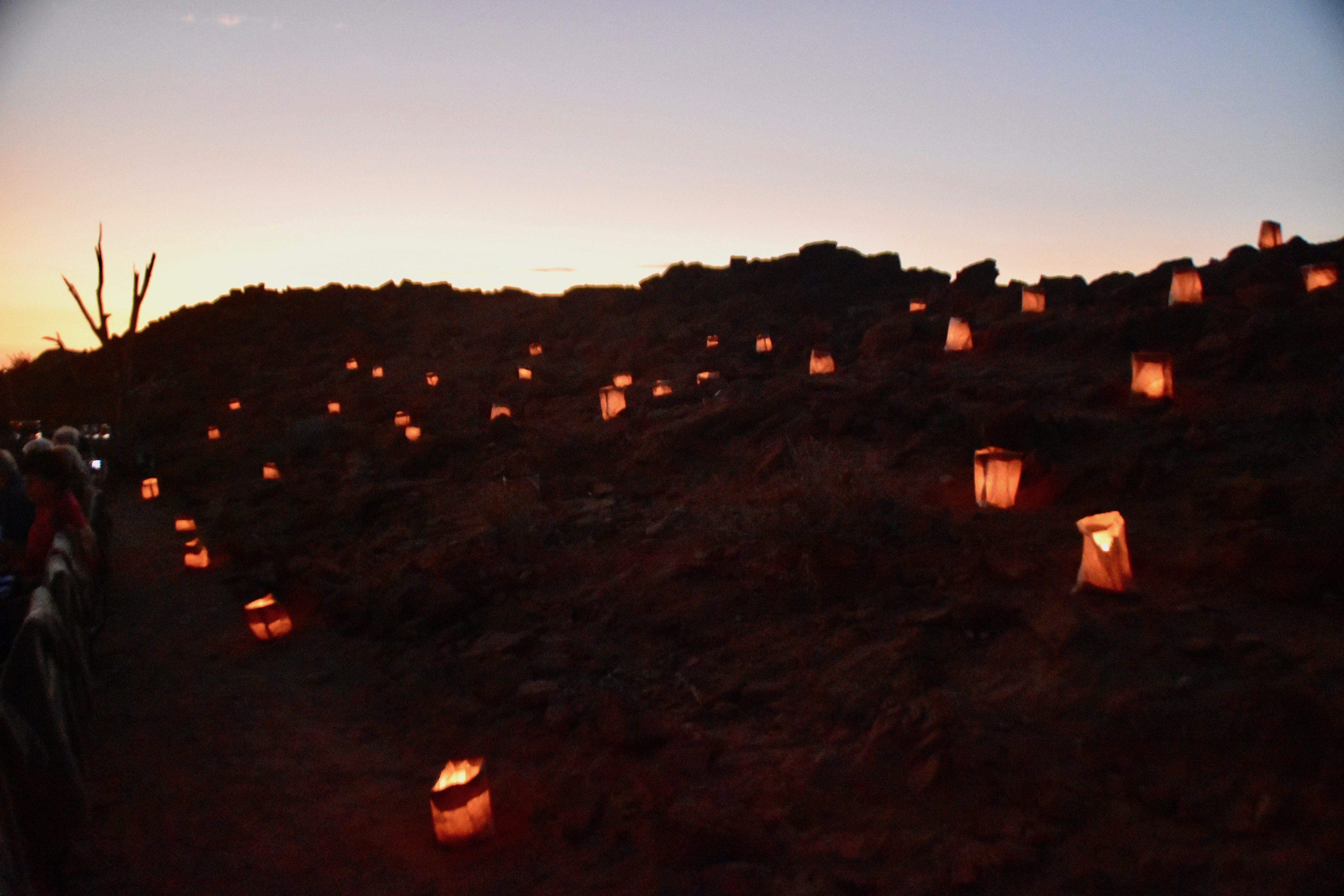
I’ll be sad to leave Damaraland, but I’m told that Etosha where we are heading for the next three days is amazing as well. I hope you’ll come along with us.

